A Review of Ionic Liquids and Their Composites with Nanoparticles for Electrochemical Applications
Abstract
:1. Introduction
2. Ionic Liquid Forms
2.1. Neat Ionic Liquids
2.2. Room Temperature Ionic Liquids
2.3. Chelate-Based Ionic Liquids
2.4. Ionic Liquid Hybrids
2.5. Ionic Liquid-Grafted Nanoparticles
2.6. Embedded Nanoparticles in Ionic Liquid with Preformed Structures
2.7. Quasi-Solid-State Ionic Liquids
3. Properties of the Ionic Liquids
3.1. Melting Point
- The ionic liquids with [NTf2]− anions have lower melting points in reference to the Br−, [BF4]−, and [PF6]− anions [159];
- In general, the inclusion of an alkoxy group typically reduces the ionic liquids’ melting point [160];
- The ionic liquids presenting unsaturated alkyl tails possess low melting points [161];
- The melting point of hex isothiocyanate complexes can be decreased by enlarging the alkyl chains in the imidazolium cation [162];
- The balance between the van der Waals and coulombic interactions regulates the melting temperature of the ionic liquids presenting distinct lengths of the alkyl chain [163];
- The hydrogen bonding of the ionic liquids augments their melting point [164];
- A dense molecular packing may induce a relatively high melting point of ionic liquids [165];
- The polar C-I bond generates a molecular dipole that promotes a denser packing, enhancing the melting point of ionic liquids [166];
- A larger anion volume in ionic liquids results in lower melting points [167].
3.2. Viscosity
3.3. Electrical Conductivity
3.4. Ionic Conductivity
3.5. Electrochemical Stability
3.6. Hygroscopicity
3.7. Polarity
3.8. Thermal Stability
4. Electrochemical Applications of the Ionic Liquids
4.1. Rechargeable Metal Batteries
4.1.1. Lithium Batteries
4.1.2. Sodium Batteries
4.1.3. Aluminum Batteries
4.1.4. Magnesium Batteries
4.1.5. Potassium Batteries
4.1.6. Calcium Batteries
4.1.7. Zinc Batteries
4.2. Fuel Cells
4.3. Dye-Sensitized Solar Cells
4.4. Thermo-Electrochemical Cells
4.5. Electrochemical Low-Grade Heat Harvesting
4.6. Supercapacitors
4.7. Electrochemical Sensors Reference Electrodes
5. Challenges and Recommendations for Future Research Works
- Further experimental investigations on the use of electrolytes composed of ionic liquids are recommended as it is still limited by the marked scarcity of ionic liquid electrolytes under room temperature conditions. Furthermore, more research work is required to attain an ameliorated knowledge of the interfacial compatibility, electrochemical stability, ionic conductivity, and working safety of the electrolytes composed of ionic liquids;
- Further molecular dynamics simulations are required to better comprehend the motion of the ions and the interactions at the ionic liquid electrolyte–electrode interface. The numeric studies and numeric simulations should be carried out according to a form to attain more valuable data on the molecular interactions and guidelines to benefit from the generalized use of the ionic liquids as fluidic electrolytes;
- More research efforts should be made to study the best possible way to integrate the different ionic liquid electrolytes and electrode components in just one single equipment for the rapid development of integrated supercapacitors operating with ionic liquids. The existing asymmetry between the anion and cations and inherent adaptability of the ionic liquids must deal with very complex van der Waals and electrostatic interactions and hydrogen bonding, to generalize the broad ionic liquid use in the manufacturing of electrodes and electrolytes to be applied in supercapacitors. Through the regulation of Lewis basicity and acidity, substituents of the alkyl chains, and other ion factors, the phase transition and thermal stability of the ionic liquids can be performed and are suitable to integrate the component requirements in only one piece of equipment [126];
- The correlation between structures and physiochemical characteristics of the ionic liquids requires further investigation to obtain a safe and improved behavior over a wide variety of temperature values. Also, some fundamental parameters need to be fully addressed like, for instance, the reduced low-temperature conduction and the high-temperature structure-driven modification of the migration model;
- Only small research attempts have been performed for the obtention of optimized dyes and electrode materials to be employed in conjunction with the ionic liquid electrolytes in dye-sensitized solar cells. Considering these facts, more and better studies are most welcome to infer the interactions between the electrolytes of ionic liquids and electrodes. These investigations should present innovative dyes, additives, and dopants for electrolytes, redox agents, and electrode materials to indeed take advantage of the beneficial features of the ionic liquid electrolytes and derivatives when employed in such types of solar cells;
- The use of in situ characterization techniques is vital to infer the transient functional and structural characteristics of the ionic liquids. To better know the electrochemical performance of the ionic liquid electrolytes and SEI formation, composition, and structure, it is critical to create and implement innovative analytical methodologies for non-invasive information retrieval during practical cell operation. The impact of temperature on the decomposition of the electrolytes and the generation of diverse inorganic species requires more profound analysis to form an SEI that can achieve an improved passivation of the anodes. Given the advancements verified with other alkali-ion batteries, modern characterization techniques should be used to better understand the influencing factors and their impact on the composition and structure of the SEI layers generated in the cells. The different characterization tools being placed into one integrated system are most welcome, since this option will provide a more comprehensive examination of the ongoing electrochemical processes in the cells. The techniques of Fourier transform spectroscopy, Raman spectroscopy, and X-ray photoelectron spectroscopy can identify the chemical composition of the SEI species, whereas atomic force microscopy can reveal the structural alteration to evaluate the thickness and strain at the electrolyte–electrode interface. These techniques can be combined to collect information on SEI, which will offer more insightful evidence to understand the correlation between the structure and the properties. Indeed, the integration of characterization devices has already made significant progress. Also, real-time examination of the growth of sodium dendrites using simultaneous mechanical measurements was already performed through in situ tunneling electron microscopy–atomic force microscopy dual characterization. Gathering data from different characterization methodologies will aid in the development of innovative ionic liquid electrolytes. To obtain accurate findings under in situ working conditions, it is essential to develop very-well-designed electrochemical cells. The associated difficulties with inaccurate and inconsistent results can be derived from lose contact between the current collector and the particles of the electrode, the presence of air and moisture in the electrolytes and electrodes of the cell, poor electrical contact, and excessive background noise. All these factors should be satisfied for the gathering of reliable data. The development of more powerful computational methods is required to more accurately estimate the underlying mechanisms of the creation, growth, and functional and structural characteristics of the SEI. Though diverse theoretical routes have been extensively followed for advanced battery research, the actual numeric simulations are elaborated with over-simplified models to avert prolonged computational times. An adequate modeling of the characteristics of the electrolytes and SEI may simulate accurately the electrochemical processes closely linked with the SEI layers. The machine learning algorithms have also demonstrated the capability of obtaining the relationship between the characteristics and structures of the ionic liquid electrolytes, and an increased throughput computation is very useful for the development of electrolytes. The computational analysis may also better elucidate the impact of the solvation sheath structure of alkali ions in the electrolyte on the SEI and may also explain the contribution of the ionic liquids to the stabilization of the interfaces between the electrolyte and the electrode in the electrochemical cells. The integration of theoretical analysis and numeric simulations with experiments is required to attain a more profound understanding of the solid-electrolyte interface to obtain guidelines for the clever design of the SEI layers on the electrodes by adjusting the main impacting factors on the SEI layers.
6. Conclusions
- Ionic liquids have great potential for electrochemical processes such as those discussed in the present review since they possess enriched electrochemical characteristics including increased electrical conductivity and electrochemical stability;
- The properties of the electrolytes based on ionic liquids should be optimized through the customized preparation of the constitutive ionic liquids, regulating the type and concentration of the components, and adjusting the temperature in which the intermolecular interactions have a critical role. The characteristics of the ionic liquid electrolytes, including the wide operating temperature range are extremely promising for applications where the goal is safe energy storage and conversion capabilities under extreme conditions;
- The correlation between the characteristics and structure of the ionic liquid precursors and carbon materials is of great relevance to improve the behavior of the electrode through anion and cation coupling;
- The different cation and anion possible arrangements in the ionic liquids embraces the interactions of van der Walls, hydrogen bonding, and electrostatic attractions, and generalizes the adoption of the ionic liquids to produce electrodes and electrolytes to be used in supercapacitors;
- There is an increasing usage of ionic liquids in the development of supercapacitors given their very attractive features including vapor pressure with negligible values and improved thermal and chemical stabilities;
- For pseudocapacitive electrodes, the energy storage ability may be considerably enhanced using novel electrolytes based on protic ionic liquids together with flexible redox mediators derived from processes of pseudo-capacitive hybrid energy storage. Furthermore, the porous quasi-solid-state ionic matrices can be adopted to mitigate the inherent environmental risks closely linked with fluid leakage, corrosivity, and assembly easiness for improved energy storage ability [126];
- Although ionic liquid electrolytes exhibit inherent safety, the leakage avoidance issue still must be assumed in quasi-solid-state electrolytes [162]. Therefore, the exploration of solid-state ionic liquid electrolytes is advisable. Nevertheless, the ion mobility can be minorly decreased. In this sense, the coordination of sites and ion conductive channels at the interfaces of the phase domains is of importance [162];
- The inclusion of ionic liquid crystal electrolytes at separators has already been demonstrated to be very suitable for the manufacturing of ionic liquid crystal membranes. Apart from this, the blend of ionic liquid crystals with polymers or the polymerization in situ [162] of the ionic liquid crystals with unsaturated bonds can also be a promising strategy. The direct contact between the ionic liquid crystal electrolytes and the electrodes, parasitic side reaction avoidance, and generation of ion conduction interphase layers could be achieved with in situ polymerization to reduce the interfacial resistance, inclusion of functional groups interacting with the solvents, and film-manufacturing additives;
- To the best of the author’s knowledge, ionic liquid reference electrodes are not yet available at a large-scale, despite their high stability and reproducibility that outperform the commercially available frit reference electrodes in some cases. It is believed that this is partially caused by the complicated and somewhat not well-defined preparation methods of the reported ionic liquid reference electrodes to date.
Author Contributions
Funding
Data Availability Statement
Conflicts of Interest
List of Symbols
| Cations | |
| [CnMIM]+ | n-Alkyl-3-methylimidazolium |
| [Cneim]+ | n-Alkyl-3-ethylimidazolium |
| [Cnpim]+ | n-Alkyl-3-propylimidazolium |
| [Cnbim]+ | n-Alkyl-3-butylimidazolium |
| [C1C2im]+ | n-Alkyl-3-n-alkylimidazolium |
| [CmMIM]+ | n-Alkyl-2,3-dimethylimidazolium |
| [Cnpy]+ | n-Alkyl pyridinium |
| [Cn(dmN)py]+ | n-Alkyl-4-(dimethylamino)pyridinium |
| [Cnmpyr]+ | n-Alkyl-1-methylpyrrolidinium |
| [Cnmpip]+ | n-Alkyl-1-methylpiperidinium |
| [Am(n)n,n,n]+ | n,n,n,n-Tetraalkylammonium |
| [n,n,n(n)Ph]+ | n,n,n,n-Tetraalkylphosphonium |
| [Pyr14]+ | 1-butyl-1-methyl-pyrrolidinium |
| [EMIM]+ | 1-ethyl-3-methyl-imidazolium |
| [N4441]+ | tributylmethyl ammonium |
| [BMIM]+ | 1-butyl-3-methylimidazolium |
| [PMIM]+ | 1-hydrogen-3-methylimidazolium |
| Anions | |
| [TFSI]− | bis(trifluoromethanesulfonyl)imide |
| [FSI]− | bis(fluorosulfonyl)imide |
| [PF6]− | hexafluorophosphate |
| [BF4]− | tetrafluoroborate |
| [TNf2]− | bis(trifluoromethylsulfonyl)imide |
| [Cl]− | chloride |
| [MeSO4]− | methyl sulfate |
| [EtSO4]− | ethyl sulfate |
| [CF3SO3]− | trifluoromethanesulfonate |
| [PNf2]− | bis(perfluoroethylsulfonyl)imide |
| [CF3COO]− | trifluoroacetate |
| [N(CN)2]− | dicyanamide |
| [C(CN)3]− | tricyanomethane |
| [AlCl4]− | tetrachloroalluminate |
| [Br]− | bromide |
| [DMP]− | dimethyl phosphate |
| [TFSA]− | bis(trifluoromethylsulfonyl)amide |
| [FSA]− | bis(fluorosulfonyl)amide |
| [OTf]− | trifluoromethane sulfonate |
References
- He, Z.; Alexandridis, P. Ionic liquid and nanoparticle hybrid systems: Emerging applications. Adv. Colloid Interface Sci. 2017, 244, 54–70. [Google Scholar] [CrossRef] [PubMed]
- De Souza, J.P.; Pivnic, K.; Bazant, M.Z.; Urbakh, M.; Kornyshev, A.A. Structural Forces in Ionic Liquids: The Role of Ionic Size Asymmetry. J. Phys. Chem. B 2022, 126, 1242–1253. [Google Scholar] [CrossRef]
- Cabry, C.P.; D’Andrea, L.; Shimizu, K.; Grillo, I.; Li, P.; Rogers, S.; Bruce, D.W.; Canongia Lopes, J.N.; Slattery, J.M. Exploring the Bulk-Phase Structure of Ionic Liquid Mixtures Using Small-Angle Neutron Scattering. Faraday Discuss. 2018, 206, 265–289. [Google Scholar] [CrossRef]
- Kurnia, K.A.; Neves, C.M.S.S.; Freire, M.G.; Santos, L.M.N.B.F.; Coutinho, J.A.P. Comprehensive study on the impact of the cation alkyl side chain length on the solubility of water in ionic liquids. J. Mol. Liq. 2015, 210 Pt B, 264–271. [Google Scholar] [CrossRef]
- Russina, O.; Triolo, A.; Gontrani, L.; Caminiti, R. Mesoscopic Structural Heterogeneities in Room-Temperature Ionic Liquids. J. Phys. Chem. Lett. 2012, 3, 27–33. [Google Scholar] [CrossRef]
- Duan, X.; Ma, J.; Lian, J.; Zheng, W. The Art of Using Ionic Liquids in the Synthesis of Inorganic Nanomaterials. CrystEngComm 2014, 16, 2550–2559. [Google Scholar] [CrossRef]
- Fellinger, T.-P.; Thomas, A.; Yuan, J.; Antonietti, M. 25th Anniversary Article: “Cooking Carbon with Salt”: Carbon Materials and Carbonaceous Frameworks from Ionic Liquids and Poly(Ionic Liquid)S. Adv. Mater. 2013, 25, 5838–5855. [Google Scholar] [CrossRef] [PubMed]
- Yuan, J.; Mecerreyes, D.; Antonietti, M. Poly(Ionic Liquid)s: An Update. Prog. Polym. Sci. 2013, 38, 1009–1036. [Google Scholar] [CrossRef]
- Nasirpour, N.; Mohammadpourfard, M.; Heris, S.Z. Ionic liquids: Promising compounds for sustainable chemical processes and applications. Chem. Eng. Res. Des. 2020, 160, 264–300. [Google Scholar] [CrossRef]
- Gui, C.; Li, G.; Zhu, R.; Lei, Z.; Dong, Y. Capturing VOCs in the pharmaceutical industry with ionic liquids. Chem. Eng. Sci. 2022, 252, 117504. [Google Scholar] [CrossRef]
- Mcneice, P.; Marr, P.C.; Marr, A.C. Basic ionic liquids for catalysis: The road to greater stability. Catal. Sci. Technol. 2021, 11, 726–741. [Google Scholar] [CrossRef]
- Hou, Y.; Zhang, Q.; Gao, M.; Ren, S.; Wu, W. Absorption and Conversion of SO2 in Functional Ionic Liquids: Effect of Water on the Claus Reaction. ACS Omega 2022, 7, 10413–10419. [Google Scholar] [CrossRef]
- Chen, S.; Dong, Y.; Sun, J.; Gu, P.; Wang, J.; Zhang, S. Ionic liquids membranes for liquid separation: Status and challenges. Green Chem. 2023, 25, 5813–5835. [Google Scholar] [CrossRef]
- Nieto de Castro, C.A.; Lamas, A.; Paredes, X.; Santos, F.J.V.; Lourenço, M.J.V.; Graber, T.A. Possible New Heat Transfer Fluid: The IoNanofluid of 1-Ethyl-3-methylimidazolium Dicyanamide + Nano-Titanium Oxide—Studying Its Thermal Conductivity and Viscosity. J. Chem. Eng. Data 2024, 69, 2227–2235. [Google Scholar] [CrossRef]
- Ghanem, A.; Nessim, M.I.; Khalil, N.A.; El-Nagar, R.A. Imidazolium-based ionic liquids as dispersants to improve the stability of asphaltene in Egyptian heavy crude oil. Sci. Rep. 2023, 13, 17158. [Google Scholar] [CrossRef]
- Lebedeva, O.; Kultin, D.; Kustov, L. Electrochemical Synthesis of Unique Nanomaterials in Ionic Liquids. Nanomaterials 2021, 11, 3270. [Google Scholar] [CrossRef]
- Al-Sallami, W.; Parsaeian, P.; Dorgham, A.; Neville, A. Effect of ionic liquids’ chemistry on their lubrication behaviour under various contact pressures. Tribol. Int. 2020, 151, 106465. [Google Scholar] [CrossRef]
- Gao, X.; Mariani, A.; Jeong, S.; Liu, X.; Dou, X.; Ding, M.; Moretti, A.; Passerini, S. Prototype rechargeable magnesium batteries using ionic liquid electrolytes. J. Power Sources 2019, 423, 52–59. [Google Scholar] [CrossRef]
- Avid, A.; Ochoa, J.L.; Huang, Y.; Liu, Y.; Atanassov, P.; Zenyuk, I.V. Revealing the role of ionic liquids in promoting fuel cell catalysts reactivity and durability. Nat. Commun. 2022, 13, 6349. [Google Scholar] [CrossRef]
- Eftekhari, A. Supercapacitors utilizing ionic liquids. Energy Storage Mater. 2017, 9, 47–69. [Google Scholar] [CrossRef]
- Deyko, G.S.; Glukhov, L.M.; Kustov, L.M. Hydrogen storage in organosilicon ionic liquids. Int. J. Hydrogen Energy 2020, 45, 33807–33817. [Google Scholar] [CrossRef]
- Al-Othman, A.; Nancarrow, P.; Tawalbeh, M.; Ka’ki, A.; El-Ahwal, K.; El Taher, B.; Alkasrawi, M. Novel composite membrane based on zirconium phosphate-ionic liquids for high temperature PEM fuel cells. Int. J. Hydrogen Energy 2021, 46, 6100–6109. [Google Scholar] [CrossRef]
- Ide, Y.; Takahashi, T.; Iwai, K.; Nozoe, K.; Habu, H.; Tokudome, S. Potential of ADN-based Ionic Liquid Propellant for Spacecraft Propulsion. Proc. Eng. 2015, 99, 332–337. [Google Scholar] [CrossRef]
- Widstrom, M.D.; Ludwig, K.B.; Matthews, J.E.; Jarry, A.; Erdi, M.; Cresce, A.V.; Rubloff, G.; Kofinas, P. Enabling high performance all-solid-state lithium metal batteries using solid polymer electrolytes plasticized with ionic liquid. Electrochim. Acta 2020, 345, 136156. [Google Scholar] [CrossRef]
- Sakaebe, H.; Matsumoto, H.; Tatsumi, K. Discharge–Charge Properties of Li/LiCoO2 Cell Using Room Temperature Ionic Liquids (RTILs) Based on Quaternary Ammonium Cation—Effect of the Structure. J. Power Sources 2005, 146, 693–697. [Google Scholar] [CrossRef]
- Nakamoto, H.; Watanabe, M. Brønsted Acid–Base Ionic Liquids for Fuel Cell Electrolytes. Chem. Commun. 2007, 2539–2541. [Google Scholar] [CrossRef]
- Ueno, K. Soft materials based on colloidal self-assembly in ionic liquids. Polym. J. 2018, 50, 951–958. [Google Scholar] [CrossRef]
- Fonseca, G.S.; Machado, G.; Teixeira, S.R.; Fecher, G.H.; Morais, J.; Alves, M.C.M.; Dupont, J. Synthesis and Characterization of Catalytic Iridium Nanoparticles in Imidazolium Ionic Liquids. J. Colloid Interface Sci. 2006, 301, 193–204. [Google Scholar] [CrossRef]
- Zhou, Y.; Antonietti, M. Synthesis of Very Small TiO2 Nanocrystals in a Room-Temperature Ionic Liquid and Their Self-Assembly toward Mesoporous Spherical Aggregates. J. Am. Chem. Soc. 2003, 125, 14960–14961. [Google Scholar] [CrossRef]
- Ravula, S.; Baker, S.N.; Kamath, G.; Baker, G.A. Ionic Liquid-Assisted Exfoliation and Dispersion: Stripping Graphene and Its Two-Dimensional Layered Inorganic Counterparts of Their Inhibitions. Nanoscale 2015, 7, 4338–4353. [Google Scholar] [CrossRef]
- Shim, Y.; Kim, H.J. Solvation of Carbon Nanotubes in a Room-Temperature Ionic Liquid. ACS Nano 2009, 3, 1693–1702. [Google Scholar] [CrossRef]
- Badgujar, K.C.; Bhanage, B.M. Factors Governing Dissolution Process of Lignocellulosic Biomass in Ionic Liquid: Current Status, Overview and Challenges. Bioresour. Technol. 2015, 178, 2–18. [Google Scholar] [CrossRef]
- Li, J.; Wei, X.; Wang, Q.; Chen, J.; Chang, G.; Kong, L.; Su, J.; Liu, Y. Homogeneous Isolation of Nanocellulose from Sugarcane Bagasse by High Pressure Homogenization. Carbohydr. Polym. 2012, 90, 1609–1613. [Google Scholar] [CrossRef]
- De Caro, D.; Jacob, K.; Hahioui, H.; Faulmann, C.; Valade, L.; Kadoya, T.; Mori, T.; Fraxedas, J.; Viau, L. Nanoparticles of Organic Conductors: Synthesis and Application as Electrode Material in Organic Field Effect Transistors. New J. Chem. 2011, 35, 1315–1319. [Google Scholar] [CrossRef]
- Xin, B.; Hao, J. Imidazolium-Based Ionic Liquids Grafted on Solid Surfaces. Chem. Soc. Rev. 2014, 43, 7171–7187. [Google Scholar] [CrossRef]
- Missan, H.P.S.; Lalia, B.S.; Karan, K.; Maxwell, A. Polymer–Ionic Liquid Nano-Composites Electrolytes: Electrical, Thermal and Morphological Properties. Mater. Sci. Eng. B 2010, 175, 143–149. [Google Scholar] [CrossRef]
- Ishikawa, M.; Sugimoto, T.; Kikuta, M.; Ishiko, E.; Kono, M. Pure Ionic Liquid Electrolytes Compatible with a Graphitiz Carbon Negative Electrode in Rechargeable Lithium-Ion Batteries. J. Power Sources 2006, 162, 658–662. [Google Scholar] [CrossRef]
- Liu, H.; Yu, H. Ionic liquids for electrochemical energy storage devices applications. J. Mater. Sci. Technol. 2019, 35, 674–686. [Google Scholar] [CrossRef]
- Zhou, T.; Gui, C.; Sun, L.; Hu, Y.; Lyu, H.; Wang, Z.; Song, Z.; Yu, G. Energy Applications of Ionic Liquids: Recent Developments and Future Prospects. Chem. Rev. 2023, 123, 12170–12253. [Google Scholar] [CrossRef] [PubMed]
- Singh, S.K.; Savoy, A.W. Ionic liquids synthesis and applications: An overview. J. Mol. Liq. 2020, 297, 112038. [Google Scholar] [CrossRef]
- Kerr, R.; Mazouzi, D.; Eftekharnia, M.; Lestriez, B.; Dupré, N.; Forsyth, M.; Guyomard, D.; Howlett, P.C. High-Capacity Retention of Si Anodes Using a Mixed Lithium/Phosphonium Bis(Fluorosulfonyl)Imide Ionic Liquid Electrolyte. ACS Energy Lett. 2017, 2, 1804–1809. [Google Scholar] [CrossRef]
- Kerner, M.; Plylahan, N.; Scheers, J.; Johansson, P. Ionic Liquid Based Lithium Battery Electrolytes: Fundamental Benefits of Utilising Both TFSI and FSI Anions? Phys. Chem. Chem. Phys. 2015, 17, 19569–19581. [Google Scholar] [CrossRef]
- Pandian, S.; Raju, S.G.; Hariharan, K.S.; Kolake, S.M.; Park, D.-H.; Lee, M.-J. Functionalized Ionic Liquids as Electrolytes for Lithium-Ion Batteries. J. Power Sources 2015, 286, 204–209. [Google Scholar] [CrossRef]
- Ohno, H. Physical properties of ionic liquids for electrochemical applications. In Electrodeposition from Ionic Liquids; Wiley Online Library: Hoboken, NJ, USA, 2017; pp. 55–94. ISBN 9783527682706. [Google Scholar]
- Navarra, M.A.; Fujimura, K.; Sgambetterra, M.; Tsurumaki, A.; Panero, S.; Nakamura, N.; Ohno, H.; Scrosati, B. New Ether-Functionalized Morpholinium- and Piperidinium-Based Ionic Liquids as Electrolyte Components in Lithium and Lithium–Ion Batteries. ChemSusChem 2017, 10, 2496–2504. [Google Scholar] [CrossRef]
- Xu, K. Electrolytes and interphases in Li-ion batteries and beyond. Chem. Rev. 2014, 114, 11503–11618. [Google Scholar] [CrossRef] [PubMed]
- El Seoud, O.A.; Keppeler, N.; Malek, N.I.; Galgano, P.D. Ionic Liquid-Based Surfactants: Recent Advances in Their Syntheses, Solution Properties, and Applications. Polymers 2021, 13, 1100. [Google Scholar] [CrossRef]
- Nancarrow, P.; Al-Othman, A.; Mital, D.K.; Döpking, S. Comprehensive analysis and correlation of ionic liquid conductivity data for energy applications. Energy 2021, 220, 119761. [Google Scholar] [CrossRef]
- Borodin, O. Challenges with prediction of battery electrolyte electrochemical stability window and guiding the electrode—Electrolyte stabilization. Curr. Opin. Electrochem. 2019, 13, 86–93. [Google Scholar] [CrossRef]
- Hallinan, D.T.; Balsara, N.P. Polymer electrolytes. Annu. Rev. Mater. Res. 2013, 43, 503–525. [Google Scholar] [CrossRef]
- Galiński, M.; Lewandowski, A.; Stępniak, I. Ionic Liquids as Electrolytes. Electrochim. Acta 2006, 51, 5567–5580. [Google Scholar] [CrossRef]
- Cheng, F.Y.; Liang, J.; Tao, Z.L.; Chen, J. Functional materials for rechargeable batteries. Adv. Mater. 2011, 23, 1695–1715. [Google Scholar] [CrossRef]
- Chen, F.-L.; Sun, I.-W.; Wang, H.P.; Huang, C.-H. Nanosize Copper Dispersed Ionic Liquids As an Electrolyte of New Dye-Sensitized Solar Cells. J. Nanomater. 2009, 2009, 472950. [Google Scholar] [CrossRef]
- Lu, Y.Y.; Das, S.K.; Moganty, S.S.; Archer, L.A. Ionic liquid-nanoparticle hybrid electrolytes and their application in secondary lithium-metal batteries. Adv. Mater. 2012, 24, 4430–4435. [Google Scholar] [CrossRef] [PubMed]
- Pereira, J.; Souza, R.; Moita, A.; Moreira, A. Nanofluids and Ionic Fluids as Liquid Electrodes: An Overview on Their Properties and Potential Applications. Processes 2023, 11, 3189. [Google Scholar] [CrossRef]
- Xu, S.; Lu, Y.; Wang, H.; Abruna, H.; Archer, L. A rechargeable Na-CO2/O2 battery enabled by stable nanoparticle hybrid electrolytes. J. Mater. Chem. A 2014, 2, 17723–17729. [Google Scholar] [CrossRef]
- Berginc, M.; Hočevar, M.; Krašovec, U.O.; Hinsch, A.; Sastrawan, R.; Topič, M. Ionic liquid-based electrolyte solidified with SiO2 nanoparticles for dye-sensitized solar cells. Thin Solid Films 2008, 516, 4645–4650. [Google Scholar] [CrossRef]
- Patil, V.; Mahajan, S.; Kulkarni, M.; Patil, K.; Rode, C.; Coronas, A.; Yi, G.R. Synthesis of silver nanoparticles colloids in imidazolium halide ionic liquids and their antibacterial activities for gram-positive and gram-negative bacteria. Chemosphere 2020, 243, 125302. [Google Scholar] [CrossRef] [PubMed]
- Júlio, A.; Lima, S.A.C.; Reis, S.; Almeida, T.S.; Fonte, P. Development of ionic liquid-polymer nanoparticle hybrid systems for delivery of poorly soluble drugs. J. Drug Deliv. Sci. Technol. 2020, 56 Pt B, 100915. [Google Scholar] [CrossRef]
- Franzoi, A.C.; Vieira, I.C.; Dupont, J.; Scheeren, C.W.; Oliveira, L.F. Biosensor for luteolin based on silver or gold nanoparticles in ionic liquid and laccase immobilized in chitosan modified with cyanuric chloride. Analyst 2009, 134, 2320–2328. [Google Scholar] [CrossRef]
- Teixeira, P.R.; Machado, T.R.; Machado, F.; Sodré, F.F.; Silva, J.G.; Neto, B.A.D.; Paterno, L.G. Au nanoparticle-poly(ionic liquid) nanocomposite electrode for the voltammetric detection of triclosan in lake water and toothpaste samples. Microchem. J. 2020, 152, 104421. [Google Scholar] [CrossRef]
- Lin, B.; Cheng, S.; Qiu, L.; Yan, F.; Shang, S.; Lu, J. Protic Ionic Liquid-Based Hybrid Proton-Conducting Membranes for Anhydrous Proton Exchange Membrane Application. Chem. Mater. 2010, 22, 1807–1813. [Google Scholar] [CrossRef]
- Xu, J.; Zhai, X.; Wu, X.; Zhang, Y.J. Allyl–aryl coupling of allylic carbonates with arylboronic acids catalyzed by palladium nanoparticles in ionic liquid. Tetrahedron 2015, 71, 1712–1717. [Google Scholar] [CrossRef]
- El-Maghlany, W.M.; Minea, A.A. Ionanofluids natural convection heat transfer and entropy generation in a rectangular cavity: Viscosity influence. J. Mol. Liq. 2021, 338, 116651. [Google Scholar] [CrossRef]
- Neves, L.A.; Coelhoso, I.M.; Crespo, J.G. Methanol and gas crossover through modified Nafion membranes by incorporation of ionic liquid cations. J. Membr. Sci. 2010, 360, 363–370. [Google Scholar] [CrossRef]
- Yamanaka, N.; Kawano, R.; Kubo, W.; Masaki, N.; Kitamura, T.; Wada, Y.; Watanabe, M.; Yanagida, S. Dye-Sensitized TiO2 Solar Cells Using Imidazolium-Type Ionic Liquid Crystal Systems as Effective Electrolytes. J. Phys. Chem. B 2007, 111, 4763–4769. [Google Scholar] [CrossRef] [PubMed]
- Qin, D.; Zhang, Y.; Huang, S.; Luo, Y.; Li, D.; Meng, Q. Ionic liquid/polymer composite electrolytes by in situ photopolymerization and their application in dye-sensitized solar cells. Electrochim. Acta 2011, 56, 8680–8687. [Google Scholar] [CrossRef]
- Lin, Y.-F.; Li, C.-T.; Lee, C.-P.; Leu, Y.A.; Ezhumalai, Y.; Vittal, R.; Chen, M.-C.; Lin, J.-J.; Ho, K.-C. Multifunctional Iodide-Free Polymeric Ionic Liquid for Quasi-Solid-State Dye-Sensitized Solar Cells with a High Open-Circuit Voltage. ACS Appl. Mater. Interfaces 2016, 8, 15267–15278. [Google Scholar] [CrossRef]
- Chi, W.S.; Ahn, S.H.; Jeon, H.; Shul, Y.G.; Kim, J.H. Rubbery copolymer electrolytes containing polymerized ionic liquid for dye-sensitized solar cells. J. Solid State Electrochem. 2012, 16, 3037–3043. [Google Scholar] [CrossRef]
- Brennecke, J.F.; Maginn, E.J. Ionic liquids: Innovative fluids for chemical processing. AIChE J. 2001, 47, 2384–2389. [Google Scholar] [CrossRef]
- Asleshirin, S.; Mazaheri, H.; Omidkhah, M.R.; Joshaghani, A.H. Investigation of Thermophysical Properties of Io Nanofluids Containing Multi-Walled Carbon Nanotubes and Graphene. Iran. J. Chem. Chem. Eng. 2022, 41, 380–391. [Google Scholar] [CrossRef]
- Chen, K.; Xu, B.; Shen, L.; Shen, D.; Li, M.; Guo, L.-H. Functions and performance of ionic liquids in enhancing electrocatalytic hydrogen evolution reactions: A comprehensive review. RSC Adv. 2022, 12, 19452–19469. [Google Scholar] [CrossRef] [PubMed]
- Hamm, S.C.; Basuray, S.; Mukherjee, S.; Sengupta, S.; Mathai, J.C.; Baker, G.A.; Gangopadhyay, S. Ionic conductivity enhancement of sputtered gold nanoparticle-in-ionic liquid electrolytes. J. Mater. Chem. A 2014, 2, 792–803. [Google Scholar] [CrossRef]
- Earle, M.J.; Seddon, K.R. Ionic liquids. Green solvents for the future. Pure Appl. Chem. 2000, 72, 1391–1398. [Google Scholar] [CrossRef]
- Marsh, K.N.; Boxall, J.A.; Lichtenthaler, R. Room temperature ionic liquids and their mixtures—A review. Fluid Phase Equilibria 2004, 219, 93–98. [Google Scholar] [CrossRef]
- Jiang, Y.; Zhang, X.; Xu, X.; Gong, S.; Wang, Z.; Zhou, Y. Mixing behavior of 1-Ethyl-3-methylimidazolium Bis(trifluoromethylsulfonyl)imide and 1-Ethyl-3-methylimidazolium tetrafluoroborate binary ionic liquids mixtures. Chem. Phys. 2023, 569, 111858. [Google Scholar] [CrossRef]
- Broder, T.L.; Silvester, D.S.; Aldous, L.; Hardacre, C.; Compton, R.G. Electrochemical Oxidation of Nitrite and the Oxidation and Reduction of NO2 in the Room Temperature Ionic Liquid [C2mim][NTf2]. J. Phys. Chem. B 2007, 111, 7778–7785. [Google Scholar] [CrossRef] [PubMed]
- Veríssimo, N.V.; Vicente, F.A.; de Oliveira, R.R.; Likozar, B.; Oliveira, R.P.S.; Pereira, J.F.B. Ionic liquids as protein stabilizers for biological and biomedical applications: A review. Biotechnol. Adv. 2022, 61, 108055. [Google Scholar] [CrossRef] [PubMed]
- Benedetto, A. Room-temperature ionic liquids meet bio-membranes: The state-of-the-art. Biophys. Rev. 2017, 9, 309–320. [Google Scholar] [CrossRef] [PubMed]
- Jiang, L.; Pan, M.; Wang, S.; Zhao, Z.; Tao, H.; Lin, W.; Li, H.; Shi, G.; Wang, C. Tunable and facile preparation of chelate-based ionic liquids for highly efficient SO2 separation under low concentration in flue gas. Sep. Purif. Technol. 2023, 318, 123979. [Google Scholar] [CrossRef]
- Kar, M.; Winther-Jensen, B.; Forsyth, M.; MacFarlane, D.R. Chelating ionic liquids for reversible zinc electrochemistry. Phys. Chem. Chem. Phys. 2013, 15, 7191–7197. [Google Scholar] [CrossRef]
- Shang, W.; Cai, T.; Zhang, Y.; Liu, D.; Sun, L.; Su, X.; Liu, S. Covalent grafting of chelated othoborate ionic liquid on carbon quantum dot towards high performance additives: Synthesis, characterization and tribological evaluation. Tribol. Int. 2018, 121, 302–309. [Google Scholar] [CrossRef]
- Riedl, J.C.; Kazemi, M.A.A.; Cousin, F.; Dubois, E.; Fantini, S.; Lois, S.; Perzynski, R.; Peyre, V. Colloidal dispersions of oxide nanoparticles in ionic liquids: Elucidating the key parameters. Nanoscale Adv. 2020, 2, 1560–1572. [Google Scholar] [CrossRef] [PubMed]
- Astruc, D. Introduction: Nanoparticles in Catalysis. Chem. Rev. 2020, 120, 461–463. [Google Scholar] [CrossRef] [PubMed]
- Seitkalieva, M.M.; Samoylenko, D.E.; Lotsman, K.A.; Rodygin, K.S.; Ananikov, V.P. Metal nanoparticles in ionic liquids: Synthesis and catalytic applications. Coord. Chem. Rev. 2021, 445, 213982. [Google Scholar] [CrossRef]
- Zheng, Y.; Wang, D.; Kaushik, S.; Zhang, S.; Wada, T.; Hwang, J.; Matsumoto, K.; Hagiwara, R. Ionic Liquid Electrolytes for Next-generation Electrochemical Energy Devices. Energy Chem. 2022, 4, 00075. [Google Scholar] [CrossRef]
- Blensdorf, T.; Joenathan, A.; Hunt, M.; Werner-Zwanziger, U.; Stein, B.D.; Mahmoud, W.E.; Al-Ghamdi, A.A.; Carini, J.; Bronstein, L.M. Hybrid composite polymer electrolytes: Ionic liquids as a magic bullet for the poly(ethylene glycol)–silica network. J. Mater. Chem. A 2017, 5, 3493–3502. [Google Scholar] [CrossRef]
- Niu, H.; Wang, L.; Guan, P.; Zhang, N.; Yan, C.; Ding, M.; Guo, X.; Huang, T.; Hu, X. Recent Advances in Application of Ionic Liquids in Electrolyte of Lithium Ion Batteries. J. Energy Storage 2021, 40, 102659. [Google Scholar] [CrossRef]
- Marquina, L.M.; Riveros, L.L.T.; Ccana, V.J.; Muedas-Taipe, G.; Isaacs, M.; Rosa-Toro, A.L. Recent studies on polymer electrolytes containing ionic liquids and their applications in lithium-ion batteries. J. Electroanal. Chem. 2023, 948, 117819. [Google Scholar] [CrossRef]
- Zhu, C.; Yang, G.; Li, H.; Du, D.; Lin, Y. Electrochemical Sensors and Biosensors Based on Nanomaterials and Nanostructures. Anal. Chem. 2015, 87, 230–249. [Google Scholar] [CrossRef]
- Chen, Y.; Han, X.; Liu, Z.; Li, Y.; Sun, H.; Wang, H.; Wang, J. Thermal decomposition and volatility of ionic liquids: Factors, evaluation and strategies. J. Mol. Liq. 2022, 366, 120336. [Google Scholar] [CrossRef]
- Gupta, P.; Rani, S.; Sah, D.; Surabhi, D.; Shabir, J.; Singh, B.; Pani, B.; Mozumdar, S. Basic ionic liquid grafted on magnetic nanoparticles: An efficient and highly active recyclable catalyst for the synthesis of β-nitroalcohols and 4H-benzo[b]pyrans. J. Mol. Struct. 2023, 1274, 134351. [Google Scholar] [CrossRef]
- Mohammed, K.J.; Hadrawi, S.K.; Kianfar, E. Synthesis and Modification of Nanoparticles with Ionic Liquids: A Review. BioNano Sci. 2023, 13, 760–783. [Google Scholar] [CrossRef]
- Vollmer, C.; Janiak, C. Naked metal nanoparticles from metal carbonyls in ionic liquids: Easy synthesis and stabilization. Coord. Chem. Rev. 2011, 255, 2039–2057. [Google Scholar] [CrossRef]
- Yang, L.; Thérien-Aubin, H. Behavior of colloidal gels made of thermoresponsive anisotropic nanoparticles. Sci. Rep. 2022, 12, 12157. [Google Scholar] [CrossRef] [PubMed]
- Opallo, M.; Lesniewski, A. A review on electrodes modified with ionic liquids. J. Electroanal. Chem. 2011, 656, 2–16. [Google Scholar] [CrossRef]
- Saputra, H.A. Electrochemical sensors: Basic principles, engineering, and state of the art. Mon. Chem. 2023, 154, 1083–1100. [Google Scholar] [CrossRef]
- Luczak, J.; Paszkiewicz, M.; Krukowska, A.; Malankowska, A.; Zaleska-Medynska, A. Ionic liquids for nano- and microstructures preparation. Part 2: Application in synthesis. Adv. Colloid Interface Sci. 2016, 227, 1–52. [Google Scholar] [CrossRef] [PubMed]
- Sakai, K.; Okada, K.; Uka, A.; Misono, T.; Endo, T.; Sasaki, S.; Abe, M.; Sakai, H. Effects of water on solvation layers of imidazolium-type room temperature ionic liquids on silica and mica. Langmuir 2015, 31, 6085–6091. [Google Scholar] [CrossRef]
- Khatri, O.P.; Adachi, K.; Murase, K.; Okazaki, K.-I.; Torimoto, T.; Tanaka, N.; Kuwabata, S.; Sugimura, H. Self-assembly of ionic liquid (BMI-PF6)-stabilized gold nanoparticles on a silicon surface: Chemical and structural aspects. Langmuir 2008, 24, 7785–7792. [Google Scholar] [CrossRef]
- Ninham, B.W. On progress in forces since the DLVO theory. Adv. Colloid Interface Sci. 1999, 83, 1–17. [Google Scholar] [CrossRef]
- Obliosca, J.M.; Arellano, I.H.J.; Huang, M.H.; Arco, S.D. Double layer micellar stabilization of gold nanocrystals by greener ionic liquid 1-butyl-3-methylimidazolium lauryl sulfate. Mater Lett 2010, 64, 1109–1112. [Google Scholar] [CrossRef]
- He, Z.; Alexandridis, P. Nanoparticles in ionic liquids: Interactions and organization. Phys. Chem. Chem. Phys. 2015, 17, 18238–18261. [Google Scholar] [CrossRef] [PubMed]
- Zhao, Y.; Hu, Z. Graphene in ionic liquids: Collective van der Waals interaction and hindrance of self-assembly pathway. J. Phys. Chem. B 2013, 117, 10540–10547. [Google Scholar] [CrossRef] [PubMed]
- Sarkar, B.; Venugopal, V.; Bodratti, A.M.; Tsianou, M.; Alexandridis, P. Nanoparticle surface modification by amphiphilic polymers in aqueous media: Role of polar organic solvents. J. Colloid Interface Sci. 2013, 397, 1–8. [Google Scholar] [CrossRef] [PubMed]
- Rodriguez-Arco, L.; Lopez-Lopez, M.T.; Duran, J.D.G.; Zubarev, A.; Chirikov, D. Stability and magnetorheological behavior of magnetic fluids based on ionic liquids. J. Phys. Condens. Matter 2011, 23, 455101. [Google Scholar] [CrossRef] [PubMed]
- Gracia, R.; Vijayakrishna, K.; Mecerreyes, D. Poly(ionic liquid)s with redox active counter-anions: All-in-one reactants and stabilizers for the synthesis of functional colloids. React. Funct. Polym. 2014, 79, 54–58. [Google Scholar] [CrossRef]
- Mallakpour, S.; Sirous, F. Surface coating of α-Al2O3 nanoparticles with poly(vinyl alcohol) as biocompatible coupling agent for improving properties of bio-active poly(amide-imide) based nanocomposites having L-phenylalanine linkages. Prog. Org. Coat 2015, 85, 138–145. [Google Scholar] [CrossRef]
- Zhang, S.-Y.; Zhuang, Q.; Zhang, M.; Wang, H.; Gao, Z.; Sun, J.-K.; Yuan, J. Poly(ionic liquid) composites. Chem. Soc. Rev. 2020, 49, 1726. [Google Scholar] [CrossRef] [PubMed]
- Texter, J.; Ager, D.; Vasantha, V.A.; Crombez, R.; England, D.; Ma, X.; Maniglia, R.; Tambe, N. Advanced nanocarbon materials facilitated by novel stimuli-responsive stabilizers. Chem. Lett. 2012, 41, 1377–1379. [Google Scholar] [CrossRef]
- Prabhu Charan, K.T.; Pothanagandhi, N.; Vijayakrishna, K.; Sivaramakrishna, A.; Mecerreyes, D.; Sreedhar, B. Poly(ionic liquids) as “smart” stabilizers for metal nanoparticles. Eur. Polym. J. 2014, 60, 114–122. [Google Scholar] [CrossRef]
- Selvam, T.; Machoke, A.; Schwieger, W. Supported ionic liquids on non-porous and porous inorganic materials. A topical review. Appl. Catal. A 2012, 445, 92–101. [Google Scholar] [CrossRef]
- Stokes, J.R.; Frith, W.J. Rheology of gelling and yielding soft matter systems. Soft Matter 2008, 4, 1133–1140. [Google Scholar] [CrossRef]
- Morozova, S.M.; Gevorkian, A.; Kumacheva, E. Design, characterization and applications of nanocolloidal hydrogels. Chem. Soc. Rev. 2023, 52, 5317–5339. [Google Scholar] [CrossRef] [PubMed]
- Ueno, K.; Hata, K.; Katakabe, T.; Kondoh, M.; Watanabe, M. Nanocomposite Ion Gels Based on Silica Nanoparticles and an Ionic Liquid: Ionic Transport, Viscoelastic Properties, and Microstructure. J. Phys. Chem. B 2008, 112, 9013–9019. [Google Scholar] [CrossRef] [PubMed]
- Hore, M.J.A.; Korley, L.T.J.; Kumar, S.K. Polymer-Grafted Nanoparticles. J. Appl. Phys. 2020, 128, 030401. [Google Scholar] [CrossRef]
- Weeks, E.R. Introduction to the Colloidal Glass Transition. ACS Macro Lett. 2017, 6, 27–34. [Google Scholar] [CrossRef] [PubMed]
- Ueno, K.; Watanabe, M. From Colloidal Stability in Ionic Liquids to Advanced Soft Materials Using Unique Media. Langmuir 2011, 27, 9105–9115. [Google Scholar] [CrossRef] [PubMed]
- Le Bideau, J.; Viau, L.; Vioux, A. Ionogels, ionic liquid based hybrid materials. Chem. Soc. Rev. 2011, 40, 907–925. [Google Scholar] [CrossRef] [PubMed]
- Wang, S.; Hsia, B.; Carraro, C.; Maboudian, R. High-performance all solid-state micro-supercapacitor based on patterned photoresist-derived porous carbon electrodes and an ionogel electrolyte. J. Mater. Chem. A 2014, 2, 7997–8002. [Google Scholar] [CrossRef]
- Yuan, Z.; Ding, J.; Zhang, Y.; Huang, B.; Song, Z.; Meng, X.; Ma, X.; Gong, X.; Huang, Z.; Ma, S.; et al. Components, mechanisms and applications of stimuli-responsive polymer gels. Eur. Polym. J. 2022, 177, 111473. [Google Scholar] [CrossRef]
- Ding, Y.; Sun, X.; Zhang, L.; Mao, S.; Xie, Z.; Liu, Z.-W.; Su, D.S. Entrapping an ionic liquid with nanocarbon: The formation of a tailorable and functional surface. Angew. Chem. Int. Ed. Engl. 2015, 54, 231–235. [Google Scholar] [CrossRef] [PubMed]
- Liu, Y.; Wu, G.; Fu, H.; Jiang, Z.; Chen, S.; Sha, M. Immobilization and melting point depression of imidazolium ionic liquids on the surface of nano-SiOx particles. Dalton Trans. 2010, 39, 3190–3194. [Google Scholar] [CrossRef] [PubMed]
- Fernandes, N.J.; Wallin, T.J.; Vaia, R.A.; Koerner, H.; Giannelis, E.P. Nanoscale ionic materials. Chem. Mater. 2014, 26, 84–96. [Google Scholar] [CrossRef]
- Li, D.; Wu, J.; Xu, X.; Wang, X.; Yang, S.; Tang, Z.; Shen, H.; Liu, X.; Zhao, N.; Xu, J. Solvent free nanoscale ionic materials based on Fe3O4 nanoparticles modified with mussel inspired ligands. J. Colloid Interface Sci. 2018, 531, 404–409. [Google Scholar] [CrossRef] [PubMed]
- Jespersen, M.L.; Mirau, P.A.; von Meerwall, E.; Vaia, R.A.; Rodriguez, R.; Giannelis, E.P. Canopy dynamics in nanoscale ionic materials. ACS Nano 2010, 4, 3735–3742. [Google Scholar] [CrossRef] [PubMed]
- Li, Q.; Dong, L.; Fang, J.; Xiong, C. Property–structure relationship of nanoscale ionic materials based on multiwalled carbon nanotubes. ACS Nano 2010, 4, 5797–5806. [Google Scholar] [CrossRef] [PubMed]
- Geng, H.; Wu, H.; Li, J.; He, X.; Shi, B.; Fan, C.; Qiu, M.; Mao, X.; Jiang, Z. Preparing proton exchange membranes via incorporating silica-based nanoscale ionic materials for the enhanced proton conductivity. Solid State Ion. 2020, 349, 115294. [Google Scholar] [CrossRef]
- Luo, H.; He, X.; Liu, G.; Niu, Y.H.; Li, G.X. Dynamics of Poly(methyl methacrylate) in Ionic Liquids with Different Concentration and Cationic Structures. Chin. J. Polym. Sci. 2023, 41, 315–324. [Google Scholar] [CrossRef]
- Kubisa, P. Ionic liquids as solvents for polymerization processes—Progress and challenges. Prog. Polym. Sci. 2009, 34, 1333–1347. [Google Scholar] [CrossRef]
- Li, R.; Han, Y.; Akcora, P. Ion channels in sulfonated copolymer-grafted nanoparticles in ionic liquids. Soft Matter 2022, 18, 5402–5409. [Google Scholar] [CrossRef]
- Xue, W.L.; Deng, W.H.; Chen, H.; Liu, R.H.; Taylor, J.M.; Li, Y.K.; Wang, L.; Deng, Y.H.; Li, W.H.; Wen, Y.Y.; et al. MOF-Directed Synthesis of Crystalline Ionic Liquids with Enhanced Proton Conduction. Angew. Chem. Int. Ed. 2021, 60, 1290–1297. [Google Scholar] [CrossRef] [PubMed]
- Yu, Z.; Yang, F.; Dai, S.; Qiao, R. Structure and Dynamics of Polymeric Canopies in Nanoscale Ionic Materials: An Electrical Double Layer Perspective. Sci. Rep. 2018, 8, 519. [Google Scholar] [CrossRef] [PubMed]
- Sarkar, B.; Lakshmichand, J.; Alexandridis, P. Self-assembly of amphiphilic block copolymers in ternary solvent mixtures: Lyotropic liquid crystalline phase behavior and structure. Macromol. Chem. Phys. 2012, 213, 2514–2528. [Google Scholar] [CrossRef]
- Goodchild, I.; Collier, L.; Millar, S.L.; Prokes, I.; Lord, J.C.D.; Butts, C.P.; Bowers, J.; Webster, J.R.; Heenan, R.K. Structural studies of the phase, aggregation and surface behavior of 1-alkyl-3-methylimidazolium halide plus water mixtures. J. Colloid Interface Sci. 2007, 307, 455–468. [Google Scholar] [CrossRef]
- Greaves, T.; Drummond, C. Solvent nanostructure, the solvophobic effect and amphiphile self-assembly in ionic liquids. Chem. Soc. Rev. 2013, 42, 1096. [Google Scholar] [CrossRef]
- Sarkar, B.; Alexandridis, P. Block copolymer-nanoparticle composites: Structure, functional properties, and processing. Prog. Polym. Sci. 2015, 40, 33–62. [Google Scholar] [CrossRef]
- Qiu, Z.M.; Texter, J. Ionic liquids in microemulsions. Curr. Opin. Colloid Interface Sci. 2008, 13, 252–262. [Google Scholar] [CrossRef]
- Frost, D.S.; Nofen, E.M.; Dai, L.L. Particle self-assembly at ionic liquid-based interfaces. Adv. Colloid Interface Sci. 2014, 206, 92–105. [Google Scholar] [CrossRef] [PubMed]
- Binks, B.P.; Dyab, A.K.F.; Fletcher, P.D.I. Novel emulsions of ionic liquids stabilized solely by silica nanoparticles. Chem. Commun. 2003, 20, 2540–2541. [Google Scholar] [CrossRef]
- Wang, A.; Chen, L.; Xu, F.; Yan, Z. In situ synthesis of copper nanoparticles within ionic liquid-in-vegetable oil microemulsions and their direct use as high efficient nanolubricants. RSC Adv. 2014, 4, 45251–45257. [Google Scholar] [CrossRef]
- Zhu, C.; Guo, S.; Zhai, Y.; Dong, S. Layer-by-layer self-assembly for constructing a graphene/platinum nanoparticle three-dimensional hybrid nanostructure using ionic liquid as a linker. Langmuir 2010, 26, 7614–7618. [Google Scholar] [CrossRef] [PubMed]
- Gelesky, M.A.; Scheeren, C.W.; Foppa, L.; Pavan, F.A.; Dias, S.L.P.; Dupont, J. Metal nanoparticle/ionic liquid/cellulose: New catalytically active membrane materials for hydrogenation reactions. Biomacromolecules 2009, 10, 1888–1893. [Google Scholar] [CrossRef] [PubMed]
- Pedro, A.Q.; Coutinho, J.A.P.; Freire, M.G. Immobilization of ionic liquids, types of materials, and applications. In Encyclopedia of Ionic Liquids; Zhang, S., Ed.; Springer: Singapore, 2019. [Google Scholar] [CrossRef]
- Zhao, M.; Gao, Y.; Zheng, L. Lyotropic liquid crystalline phases formed in binary mixture of 1-tetradecyl-3-methylimidazolium chloride/ethylammonium nitrate and its application in the dispersion of multi-walled carbon nanotubes. Colloids Surfaces A Physicochem. Eng. Asp. 2010, 369, 95–100. [Google Scholar] [CrossRef]
- Hejazifar, M.; Lanaridi, O.; Bica-Schröder, K. Ionic liquid based microemulsions: A review. J. Mol. Liq. 2020, 303, 112264. [Google Scholar] [CrossRef]
- Kataria, J.; Devi, P.; Rani, P. Importance of structures and interactions in ionic liquid-nanomaterial composite systems as a novel approach for their utilization in safe lithium metal batteries: A review. J. Mol. Liq. 2021, 339, 116736. [Google Scholar] [CrossRef]
- Guo, Y.; He, D.; Xia, S.; Xie, X.; Gao, X.; Zhang, Q. Preparation of a Novel Nanocomposite of Polyaniline Core Decorated with Anatase-TiO2 Nanoparticles in Ionic Liquid/Water Microemulsion. J. Nanomater. 2012, 2012, 202794. [Google Scholar] [CrossRef]
- Pei, Y.; Ru, J.; Yao, K.; Hao, L.; Li, Z.; Wang, H.; Zhuc, X.; Wang, J. Nanoreactors stable up to 200 °C: A class of high temperature microemulsions composed solely of ionic liquids. Chem. Commun. 2018, 54, 6260–6263. [Google Scholar] [CrossRef]
- Shahrokhian, S.; Rastgar, S. Electrochemical deposition of gold nanoparticles on carbon nanotube coated glassy carbon electrode for the improved sensing of tinidazole. Electrochim. Acta 2012, 78, 422–429. [Google Scholar] [CrossRef]
- Miao, L.; Song, Z.; Zhu, D.; Li, L.; Gan, L.; Liu, M. Ionic Liquids for Supercapacitive Energy Storage: A Mini-Review. Energy Fuels 2021, 35, 8443–8455. [Google Scholar] [CrossRef]
- Qian, W.; Texter, J.; Yan, F. Frontiers in poly(ionic liquid)s: Syntheses and applications. Chem. Soc. Rev. 2017, 46, 1124–1159. [Google Scholar] [CrossRef]
- Pan, Z.; Yang, J.; Zhang, Q.; Liu, M.; Hu, Y.; Kou, Z.; Liu, N.; Yang, X.; Ding, X.; Chen, H.; et al. All-solid-state fiber supercapacitors with ultrahigh volumetric energy density and outstanding flexibility. Adv. Energy Mater. 2019, 9, 1802753. [Google Scholar] [CrossRef]
- Rana, H.H.; Park, J.H.; Gund, G.S.; Park, H.S. Highly conducting, extremely durable, phosphorylated cellulose-based ionogels for renewable flexible supercapacitors. Energy Storage Mater. 2020, 25, 70–75. [Google Scholar] [CrossRef]
- Li, H.; Feng, Z.; Zhao, K.; Wang, Z.; Liu, J.; Liu, J.; Song, H. Chemically crosslinked liquid crystalline poly(ionic liquid)s/halloysite nanotubes nanocomposite ionogels with superior ionic conductivity, high anisotropic conductivity and a high modulus. Nanoscale 2019, 11, 3689–3700. [Google Scholar] [CrossRef] [PubMed]
- Li, L.; Yang, X.; Li, J.; Xu, Y. A novel and shortcut method to prepare ionic liquid gel polymer electrolyte membranes for lithium-ion battery. Ionics 2018, 24, 735–741. [Google Scholar] [CrossRef]
- Hagiwara, R.; Matsumoto, K.; Hwang, J.; Nohira, T. Sodium Ion Batteries using Ionic Liquids as Electrolytes. Chem. Rec. 2019, 19, 758–770. [Google Scholar] [CrossRef] [PubMed]
- Kubota, K.; Nohira, T.; Hagiwara, R. New inorganic ionic liquids possessing low melting temperatures and wide electrochemical windows: Ternary mixtures of alkali bis(fluorosulfonyl)amides. Electrochim. Acta 2012, 66, 320–324. [Google Scholar] [CrossRef]
- Langtry, A.E.; Thompson, K.B.; Redeker, N.D.; Quintana, A.S.; Bui, D.L.; Greeson, K.T.; Cena, N.; Marcihak, J.C.; Moore, L.M.J.; Ghiassi, K.B. Fluorinated phosphonium salts and ionic liquids prepared via thiol-ene click chemistry: A physical and thermal property study. J. Mol. Liq. 2022, 359, 119282. [Google Scholar] [CrossRef]
- Warrington, A.; Kang, C.S.M.; Forsyth, C.; Doherty, C.M.; Acharya, D.; O’dell, L.A.; Sirigiri, N.; Boyle, J.W.; Hutt, O.E.; Forsyth, M.; et al. Thermal, structural and dynamic properties of ionic liquids and organic ionic plastic crystals with a small ether-functionalized cation. Mater. Chem. Front. 2022, 6, 1437–1455. [Google Scholar] [CrossRef]
- Del Río, E.; Vidil, T.; Gati, W.; Grau, E.; Taton, D.; Cramail, H. Ester-Containing Imidazolium-Type Ionic Liquid Crystals Derivedfrom Bio-based Fatty Alcohols. ACS Sustain. Chem. Eng. 2021, 9, 12687–12698. [Google Scholar] [CrossRef]
- Peppel, T.; Köckerling, M. New Low-Melting Triply Charged Homoleptic Cr(III)-Based Ionic Liquids in Comparison to Their Singly Charged Heteroleptic Analogues. Materials 2021, 14, 2676. [Google Scholar] [CrossRef]
- Turner, E.A.; Pye, C.C.; Singer, R.D. Use of ab Initio Calculations toward the Rational Design of Room Temperature Ionic Liquids. J. Phys. Chem. A 2003, 107, 2277–2288. [Google Scholar] [CrossRef]
- Myrdek, T.; Popescu, C.; Kunz, W. Physical-chemical properties of newly synthesized tetraalkylammonium alkyl ether carboxylate ionic liquids. J. Mol. Liq. 2021, 322, 114947. [Google Scholar] [CrossRef]
- Sumitani, R.; Mochida, T. Thermal properties, crystal structures, and photoreactivity of Ru-containing ionic liquids with sulfur-containing substituents. J. Mol. Liq. 2021, 344, 117784. [Google Scholar] [CrossRef]
- Niemczak, M.; Sobiech, L.; Grzanka, M. Iodosulfuron-Methyl-Based Herbicidal Ionic Liquids Comprising Alkyl Betainate Cation as Novel Active Ingredients with Reduced Environmental Impact and Excellent Efficacy. J. Agric. Food Chem. 2020, 68, 13661–13671. [Google Scholar] [CrossRef]
- Liu, J.; Yang, W.; Li, Z.; Ren, F.; Hao, H. Experimental investigation of thermo-physical properties of geminal dicationic ionic compounds for latent thermal energy storage. J. Mol. Liq. 2020, 307, 112994. [Google Scholar] [CrossRef]
- Yang, F.; Wang, B.; Jiao, Y.; Tan, H.; Wang, X. Density and Viscosity of Three Ionic Liquids with 2,2,2-Trifluoroethanol. J. Chem. Thermodyn. 2023, 181, 107038. [Google Scholar] [CrossRef]
- Li, Z.; Feng, Z.; Jin, H.; Li, K.; Xia, H.; Qu, S.; Ye, S.; Cheng, H.; Wei, Q.; Li, Y.; et al. Absorption Characteristics and Molecular Mechanism of a Low Viscosity Iron-Based Ionic Liquid for Removing H2S. J. Environ. Chem. Eng. 2024, 12, 113030. [Google Scholar] [CrossRef]
- Shah, M.S.; Tsapatsis, M.; Siepmann, J.I. Hydrogen Sulfide Capture: From Absorption in Polar Liquids to Oxide, Zeolite, and Metal–Organic Framework Adsorbents and Membranes. Chem. Rev. 2017, 117, 9755–9803. [Google Scholar] [CrossRef]
- Liu, J.; Mao, J.; Yun, Y.; Wang, M.; Liu, G.; Li, C.; Yang, W.; Li, M.; Liu, Z. An Amino Acid Ionic Liquid-Based Biphasic Solvent with Low Viscosity, Small Rich-Phase Volume, and High CO2 Loading Rate for Efficient CO2 Capture. Sep. Purif. Technol. 2024, 347, 127592. [Google Scholar] [CrossRef]
- Liu, Q.-S.; Liu, J.; Liu, X.-X.; Zhang, S.-T. Density, dynamic viscosity, and electrical conductivity of two hydrophobic functionalized ionic liquids. J. Chem. Thermodyn. 2015, 90, 9–45. [Google Scholar] [CrossRef]
- Liu, Q.; Zhou, X.; Yang, S.R.; Zhang, W.; Liu, H.; Guo, C.-A.; Zhang, J. Study on Electric Conductivity of Quaternary Ammonium Ionic Liquids. Russ. J. Phys. Chem. 2023, 97, 1466–1474. [Google Scholar] [CrossRef]
- Zhang, Y.; Xie, X.; Liu, J.; Tang, B.; Fang, C.; Liu, X.; Dai, Z.; Xiong, Y. Ionic liquids with reversible photo-induced conductivity regulation in aqueous solution. Sci. Rep. 2023, 13, 13766. [Google Scholar] [CrossRef] [PubMed]
- Alizadeh, J.; Keshavarz Moraveji, M. An Experimental Evaluation on Thermophysical Properties of Functionalized Graphene Nanoplatelets Ionanofluids. Int. Commun. Heat Mass Transf. 2018, 98, 31–40. [Google Scholar] [CrossRef]
- Chereches, E.; Minea, A.A. Experimental evaluation of electrical conductivity of ionanofluids based on water–[C2mim][CH3SO3] ionic liquids mixtures and alumina nanoparticles. J. Therm. Anal. Calorim. 2020, 145, 3151–3157. [Google Scholar] [CrossRef]
- Das, L.; Habib, K.; Saidur, R.; Aslfattahi, N.; Yahya, S.M.; Rubbi, F. Improved Thermophysical Properties and Energy Efficiency of Aqueous Ionic Liquid/MXene Nanofluid in a Hybrid PV/T Solar System. Nanomaterials 2020, 10, 1372. [Google Scholar] [CrossRef] [PubMed]
- Deb, D.; Dutta, B.; Bhattacharya, S. Viscosity Decoupled Charge Transport in Surface Functionalized ZnS Nanoparticle Dispersed Imidazolium Ionanofluids. Mater. Res. Bull. 2019, 116, 22–31. [Google Scholar] [CrossRef]
- Freire, M.G.; Neves, C.M.S.S.; Marrucho, I.M.; Coutinho, J.A.P.; Fernandes, A.M. Hydrolysis of Tetrafluoroborate and Hexafluorophosphate Counter Ions in Imidazolium-Based Ionic Liquids. J. Phys. Chem. A 2010, 114, 3744–3749. [Google Scholar] [CrossRef]
- Chen, Z.; Chao, Y.; Li, W.; Wallace, G.G.; Bussell, T.; Ding, J.; Wang, C. Abuse-Tolerant Electrolytes for Lithium-Ion Batteries. Adv. Sci. 2021, 8, 2003694. [Google Scholar] [CrossRef]
- Rana, S.; Thakur, R.C.; Dosanjh, H.S. Ionic liquids as battery electrolytes for lithium-ion batteries: Recent advances and future prospects. Solid State Ion. 2023, 400, 116340. [Google Scholar] [CrossRef]
- Tsurumaki, A.; Ohno, H.; Panero, S.; Navarra, M.A. Novel bis(fluorosulfonyl)imide-based and ether-functionalized ionic liquids for lithium batteries with improved cycling properties. Electrochim. Acta 2019, 293, 160–165. [Google Scholar] [CrossRef]
- Nirmale, T.C.; Khupse, N.D.; Kalubarme, R.S.; Kulkarni, M.V.; Varma, A.J.; Kale, B.B. Imidazolium-Based Dicationic Ionic Liquid Electrolyte: Strategy toward Safer Lithium-Ion Batteries. ACS Sustain. Chem. Eng. 2022, 10, 8297–8304. [Google Scholar] [CrossRef]
- Lei, Z.; Chen, B.; Koo, Y.-M.; MacFarlane, D.R. Introduction: Ionic Liquids. Chem. Rev. 2017, 117, 6633–6635. [Google Scholar] [CrossRef] [PubMed]
- Kim, O.; Kim, K.; Choi, U.H.; Park, M.J. Tuning anhydrous proton conduction in single-ion polymers by crystalline ion channels. Nat. Commun. 2018, 9, 5029. [Google Scholar] [CrossRef] [PubMed]
- Mei, X.; Yue, Z.; Ma, Q.; Dunya, H.; Mandal, B.K. Synthesis and electrochemical properties of new dicationic ionic liquids. J. Mol. Liq. 2018, 272, 1001–1018. [Google Scholar] [CrossRef]
- Ruan, Q.; Yao, M.; Yuan, D.; Dong, H.; Liu, J.; Yuan, X.; Fang, W.; Zhao, G.; Zhang, H. Ionic liquid crystal electrolytes: Fundamental, applications and prospects. Nano Energy 2023, 106, 108087. [Google Scholar] [CrossRef]
- Dalir, N.; Javadian, S.S.M.; Javad Ghavam, S.M.J.; Gharibi, H. The Critical Role of Ionic Liquid Crystal on Mg2+ Ion Transport Properties in Magnesium Ion Batteries; Performance and Mechanism Approach. J. Electrochem. Soc. 2021, 168, 070519. [Google Scholar] [CrossRef]
- Liu, X.; Mariani, A.; Zarrabeitia, M.; Di Pietro, M.E.; Dong, X.; Elia, G.A.; Mele, A.; Passerini, S. Effect of organic cations in locally concentrated ionic liquid electrolytes on the electrochemical performance of lithium metal batteries. Energy Storage Mater. 2022, 44, 370–378. [Google Scholar] [CrossRef]
- Swiderska-Mocek, A. Electrolyte based on 1-ethyl-3-vinylimidazolium bis(trifluoromethanesulphonyl)imide for Li-ion batteries. Electrochim. Acta 2014, 132, 504–511. [Google Scholar] [CrossRef]
- Makhlooghiazad, F.; Mejía, L.M.G.; Rollo-Walker, G.; Kourati, D.; Galceran, M.; Chen, F.; Deschamps, M.; Howlett, P.; O’Dell, L.A.; Forsyth, M. Understanding Polymerized Ionic Liquids as Solid Polymer Electrolytes for Sodium Batteries. J. Am. Chem. Soc. 2024, 146, 1992–2004. [Google Scholar] [CrossRef]
- Forsyth, M.; Yoon, H.; Chen, F.; Zhu, H.; MacFarlane, D.R.; Armand, M.; Howlett, P.C. Novel Na+ Ion Diffusion Mechanism in Mixed Organic–Inorganic Ionic Liquid Electrolyte Leading to High Na+ Transference Number and Stable, High Rate Electrochemical Cycling of Sodium Cells. J. Phys. Chem. C 2016, 120, 4276–4286. [Google Scholar] [CrossRef]
- Wang, C.-H.; Yeh, Y.-W.; Wongittharom, N.; Wang, Y.-C.; Tseng, C.-J.; Lee, S.-W.; Chang, W.-S.; Chang, J.-K. Rechargeable Na/Na0.44MnO2 cells with ionic liquid electrolytes containing various sodium solutes. J. Power Sources 2015, 274, 1016–1023. [Google Scholar] [CrossRef]
- Bellusci, M.; Simonetti, E.; De Francesco, M.; Appetecchi, G.B. Ionic Liquid Electrolytes for Safer and More Reliable Sodium Battery Systems. Appl. Sci. 2020, 10, 6323. [Google Scholar] [CrossRef]
- Elterman, V.A.; Shevelin, P.Y.; Chizhov, D.L.; Yolshina, L.A.; Il’ina, E.A.; Borozdin, A.V.; Kodess, M.I.; Ezhikova, M.A.; Rusinov, G.L. Development of a novel 1-trifluoroacetyl piperidine-based electrolyte for aluminum ion battery. Electrochim. Acta 2019, 323, 134806. [Google Scholar] [CrossRef]
- Zhu, G.; Angell, M.; Pan, C.-J.; Lin, M.-C.; Chen, H.; Haung, C.-J.; Lin, J.; Achazi, A.J.; Kaghazchi, P.; Hwang, B.-J.; et al. Rechargeable aluminum batteries: Effects of cations in ionic liquid electrolytes. RSC Adv. 2019, 9, 11322–11330. [Google Scholar] [CrossRef]
- Lahiri, A.; Guan, S.; Chutia, A. Modulating Aluminum Solvation with Ionic Liquids for Improved Aqueous-Based Aluminum-Ion Batteries. ACS Appl. Energy Mater. 2023, 6, 11874–11881. [Google Scholar] [CrossRef]
- Ren, W.; Wu, D.; Li, Y.N.; Zhang, X.; Yang, J.; Wang, J. A Chlorine-Free Electrolyte Based on Non-nucleophilic Magnesium Bis(diisopropyl)amide and Ionic Liquid for Rechargeable Magnesium Batteries. ACS Appl. Mater. Interfaces 2021, 13, 32957–32967. [Google Scholar] [CrossRef]
- Vardar, G.; Sleightholme, A.E.S.; Naruse, J.; Hiramatsu, H.; JSiegel, D.J.; Monroe, C.W. Electrochemistry of Magnesium Electrolytes in Ionic Liquids for Secondary Batteries. ACS Appl. Mater. Interfaces 2014, 6, 18033–18039. [Google Scholar] [CrossRef]
- Yoshii, K.; Masese, T.; Kato, M.; Kubota, K.; Senoh, H.; Shikano, M. Sulfonylamide-Based Ionic Liquids for High-Voltage Potassium-Ion Batteries with Honeycomb Layered Cathode Oxides. ChemElectroChem 2019, 6, 3901–3910. [Google Scholar] [CrossRef]
- Jeon, J.; Kang, S.; Koo, S.B.; Kim, H.; Hong, S.-T.; Lee, H. Long-life potassium metal batteries enabled by anion-derived solid electrolyte interphase using concentrated ionic liquid electrolytes. J. Colloid Interface Sci. 2024, 670, 617–625. [Google Scholar] [CrossRef]
- Dhir, S.; Jagger, B.; Maguire, A.; Pasta, M. Fundamental investigations on the ionic transport and thermodynamic properties of non-aqueous potassium-ion electrolytes. Nat. Commun. 2023, 14, 3833. [Google Scholar] [CrossRef]
- Stettner, T.; Dugas, R.; Ponrouch, A.; Balducci, A. Ionic Liquid-Based Electrolytes for Calcium-Based Energy Storage Systems. J. Electrochem. Soc. 2020, 167, 100544. [Google Scholar] [CrossRef]
- Biria, S.; Pathreeker, S.; Genier, F.S.; Hosein, I.D. A Highly Conductive and Thermally Stable Ionic Liquid Gel Electrolyte for Calcium-Ion Batteries. ACS Appl. Polym. Mater. 2020, 2, 2111–2118. [Google Scholar] [CrossRef]
- Yu, L.; Huang, J.; Wang, S.; Qi, L.; Wang, S.; Chen, C. Ionic Liquid “Water Pocket” for Stable and Environment-Adaptable Aqueous Zinc Metal Batteries. Adv. Mater. 2023, 35, 2210789. [Google Scholar] [CrossRef] [PubMed]
- Liu, Z.; Pulletikurthi, G.; Endres, F. A Prussian Blue/Zinc Secondary Battery with a Bio-Ionic Liquid–Water Mixture as Electrolyte. ACS Appl. Mater. Interfaces 2016, 8, 12158–12164. [Google Scholar] [CrossRef] [PubMed]
- Zhang, T.; Shi, X.; Li, Y.; Sangaraju, S.; Wang, F.; Yang, L.; Ran, F. Carboxylic bacterial cellulose fiber-based hydrogel electrolyte with imidazole-type ionic liquid for dendrite-free zinc metal batteries. Mater. Rep. Energy 2024, 4, 100272. [Google Scholar] [CrossRef]
- Sorenson, G.P.; Coppage, K.L.; Mahanthappa, M.K. Unusually stable aqueous lyotropic gyroid phases from gemini dicarboxylate surfactants. J. Am. Chem. Soc. 2011, 133, 14928–14931. [Google Scholar] [CrossRef]
- Ichikawa, T.; Kato, T.; Ohno, H. 3D continuous water nanosheet as a gyroid minimal surface formed by bicontinuous cubic liquid-crystalline Zwitterions. J. Am. Chem. Soc. 2012, 134, 11354–11357. [Google Scholar] [CrossRef] [PubMed]
- Lu, F.; Gao, X.; Dong, B.; Sun, P.; Sun, N.; Xie, S.; Zheng, L. Nanostructured proton conductors formed via in situ polymerization of ionic liquid crystals. ACS Appl. Mater. Interfaces 2014, 6, 21970–21977. [Google Scholar] [CrossRef]
- Luo, J.; You, J.; Tan, S.; Wang, C.; Wu, Y. Lamellar lyotropic liquid crystal superior to micellar solution for proton conduction in an aqueous solution of 1-tetradecyl3-methylimidazolium hydrogen sulfate. ACS Appl. Mater. Interfaces 2020, 12, 45611–45617. [Google Scholar] [CrossRef]
- Kobayashi, T.; Li, Y.-X.; Hirota, Y.; Maekawa, A.; Nishiyama, N.; Zeng, X.-B.; Ichikawa, T. Gyroid-nanostructured all-solid polymer films combining high H+ conductivity with low H2 permeability. Macromol. Rapid Commun. 2021, 42, 2100115. [Google Scholar] [CrossRef]
- Lee, W.; Lee, J.; Min, S.K.; Park, T.; Yi, W.; Han, S.-H. Effect of Single-Walled Carbon Nanotube in PbS/TiO2 Quantum Dots-Sensitized Solar Cells. Mater. Sci. Eng. B 2009, 156, 48–51. [Google Scholar] [CrossRef]
- Neo, C.Y.; Ouyang, J. Functionalized carbon nanotube-induced viscosity reduction of an ionic liquid and performance improvement of dye-sensitized solar cells. Electrochim. Acta 2012, 85, 1–8. [Google Scholar] [CrossRef]
- Adhyaksa, G.W.; Baek, S.W.; Lee, G.I.; Lee, D.K.; Lee, J.Y.; Kang, J.K. Coupled near- and far-field scattering in silver nanoparticles for high-efficiency, stable, and thin plasmonic dye-sensitized solar cells. ChemSusChem 2014, 7, 2461–2468. [Google Scholar] [CrossRef] [PubMed]
- Sharma, T.; Gultekin, B.; Dhapola, P.S.; Sahoo, N.G.; Kumar, S.; Agarwal, D.; Jun, H.K.; Singh, D.; Nath, G.; Singh, P.K.; et al. Ionic liquid doped Poly (methyl methacrylate) for energy applications. J. Mol. Liq. 2022, 352, 118494. [Google Scholar] [CrossRef]
- Zhao, D.; Würger, A.; Crispin, X. Ionic thermoelectric materials and devices. J. Energy Chem. 2021, 61, 88–103. [Google Scholar] [CrossRef]
- Abraham, T.J.; MacFarlane, D.R.; Baughman, R.H.; Jin, L.; Li, N.; Pringle, J.M. Towards ionic liquid-based thermoelectrochemical cells for the harvesting of thermal energy. Electrochim. Acta 2013, 113, 87–93. [Google Scholar] [CrossRef]
- Cheng, H.; He, X.; Fan, Z.; Ouyang, J. Flexible Quasi-Solid State Ionogels with Remarkable Seebeck Coefficient and High Thermoelectric Properties. Adv. Energy Mater. 2019, 9, 1901085. [Google Scholar] [CrossRef]
- Chen, B.; Chen, Q.; Xiao, S.; Feng, J.; Zhang, X.; Wang, T. Giant Negative Thermopower of Ionic Hydrogel by Synergistic Coordination and Hydration Interactions. Sci. Adv. 2023, 7, eabi7233. [Google Scholar] [CrossRef] [PubMed]
- Wu, A.; Li, X.; Lee, D.; Li, J.; Yun, J.; Jiang, C.; Li, Z.; Lee, S.W. Thermoresponsive ionic liquid for electrochemical low-grade heat harvesting. Nano Energy 2023, 105, 108022. [Google Scholar] [CrossRef]
- Mousavi, M.P.S.; Kashefolgheta, S.; Stein, A.; Bühlmann, P. Electrochemical Stability of Quaternary Ammonium Cations: An Experimental and Computational Study. J. Electrochem. Soc. 2015, 163, H74–H80. [Google Scholar] [CrossRef]
- Sakaebe, H.; Matsumoto, H. N-Methyl-N-propylpiperidinium bis (trifluoromethanesulfonyl)imide (PP13–TFSI)—Novel electrolyte base for Li battery. Electrochem. Commun. 2003, 5, 594–598. [Google Scholar] [CrossRef]
- Ding, C.; Nohira, T.; Hagiwara, R.; Matsumoto, K.; Okamoto, Y.; Fukunaga, A.; Sakai, S.; Nitta, K.; Inazawa, S. Na[FSA]-[C3C1pyrr][FSA] ionic liquids as electrolytes for sodium secondary batteries: Effects of Na ion concentration and operation temperature. J. Power Sources 2014, 269, 124–128. [Google Scholar] [CrossRef]
- Yao, M.; Liu, A.; Xing, C.; Li, B.; Pan, S.; Zhang, J.; Su, P.; Zhang, H. Asymmetric supercapacitor comprising a core-shell TiNb2O7@MoS2/C anode and a high voltage ionogel electrolyte. Chem. Eng. J. 2020, 394, 124883. [Google Scholar] [CrossRef]
- Wang, Y.; Song, Y.; Xia, Y. Electrochemical capacitors: Mechanism, materials, systems, characterization, and applications. Chem. Soc. Rev. 2016, 45, 5925–5950. [Google Scholar] [CrossRef] [PubMed]
- Lai, F.; Feng, J.; Yan, R.; Wang, G.C.; Antonietti, M.; Oschatz, M. Breaking the limits of ionic liquid-based supercapacitors: Mesoporous carbon electrodes functionalized with manganese oxide nanosplotches for dense, stable, and wide-temperature energy storage. Adv. Funct. Mater. 2018, 28, 1801298. [Google Scholar] [CrossRef]
- Mo, T.; Bi, S.; Zhang, Y.; Presser, V.; Wang, X.; Gogotsi, Y.; Feng, G. Ion structure transition enhances charging dynamics in subnanometer pores. ACS Nano 2020, 14, 2395–2403. [Google Scholar] [CrossRef] [PubMed]
- Nguyen, Q.D.; Patra, J.; Hsieh, C.; Li, J.; Dong, Q.; Chang, J.K. Supercapacitive properties of micropore- and mesopore-rich activated carbon in ionic-liquid electrolytes with various constituent ions. ChemSusChem 2019, 12, 449–456. [Google Scholar] [CrossRef] [PubMed]
- Wang, X.; Zhou, H.; Sheridan, E.; Walmsley, J.C.; Ren, D.; Chen, D. Geometrically confined favorable ion packing for high gravimetric capacitance in carbon–ionic liquid supercapacitors. Energy Environ. Sci. 2016, 9, 232–239. [Google Scholar] [CrossRef]
- Pan, H.; Zhang, Y.; Pan, Y.; Lin, W.; Tu, W.; Zhang, H. Nitrogen-doped porous carbon with interconnected tubular structure for supercapacitors operating at sub-ambient temperatures. Chem. Eng. J. 2020, 401, 126083. [Google Scholar] [CrossRef]
- Bi, S.; Banda, H.; Chen, M.; Niu, L.; Chen, M.; Wu, T.; Wang, J.; Wang, R.; Feng, J.; Chen, T.; et al. Molecular understanding of charge storage and charging dynamics in supercapacitors with MOF electrodes and ionic liquid electrolytes. Nat. Mater. 2020, 19, 552–558. [Google Scholar] [CrossRef]
- Rochefort, D.; Pont, A.-L. Pseudocapacitive behavior of RuO2 in a proton exchange ionic liquid. Electrochem. Commun. 2006, 8, 1539–1543. [Google Scholar] [CrossRef]
- Shen, B.; Guo, R.; Lang, J.; Liu, L.; Liu, L.; Yan, X. A high-temperature flexible supercapacitor based on pseudocapacitive behavior of FeOOH in an ionic liquid electrolyte. J. Mater. Chem. A 2016, 4, 8316–8327. [Google Scholar] [CrossRef]
- Molinari, A.; Leufke, P.; Reitz, C.; Dasgupta, S.; Witte, R.; Kruk, R.; Hahn, H. Hybrid supercapacitors for reversible control of magnetism. Nat. Commun. 2017, 8, 15339. [Google Scholar] [CrossRef] [PubMed]
- Varela, C.J.; Sankar, K.; Hino, A.; Lin, X.; Chang, W.-S.; Coker, D.; Grinstaff, M. Piperidinium ionic liquids as electrolyte solvents for sustained high temperature supercapacitor operation. Chem. Commun. 2018, 54, 5590–5593. [Google Scholar] [CrossRef] [PubMed]
- Yan, R.; Antonietti, M.; Oschatz, M. Toward the experimental understanding of the energy storage mechanism and ion dynamics in ionic liquid-based supercapacitors. Adv. Energy Mater. 2018, 8, 1800026. [Google Scholar] [CrossRef]
- Wang, Y.; Qian, C.; Huo, F.; Qin, J.; He, H. Molecular mechanism of anion size regulating the nanostructure and charging process at ionic liquid-electrode interfaces. J. Mater. Chem. A 2020, 8, 19908–19916. [Google Scholar] [CrossRef]
- Tsai, W.-Y.; Lin, R.; Murali, S.; Li Zhang, L.; McDonough, J.K.; Ruoff, R.S.; Taberna, P.-L.; Gogotsi, Y.; Simon, P. Outstanding performance of activated graphene based supercapacitors in ionic liquid electrolyte from −50 to 80 °C. Nano Energy 2013, 2, 403–411. [Google Scholar] [CrossRef]
- Wang, X.; Mehandzhiyski, A.Y.; Arstad, B.; Van Aken, K.L.; Mathis, T.S.; Gallegos, A.; Tian, Z.; Ren, D.; Sheridan, E.; Grimes, B.A.; et al. Selective charging behavior in an ionic mixture electrolyte-supercapacitor system for higher energy and power. J. Am. Chem. Soc. 2017, 139, 18681–18687. [Google Scholar] [CrossRef]
- Dou, Q.; Lian, C.; Lei, S.; Chen, J.; Liu, H.; Yan, X. Silica-grafted ionic liquid for maximizing the operational voltage of electrical double-layer capacitors. Energy Storage Mater. 2019, 18, 253–259. [Google Scholar] [CrossRef]
- Punnakkal, N.; Satheesh Babu, T.G.; Nair, B.G.; Suneesh, P.V. Redox active electrolytes in supercapacitors. In Nanostructured Materials for Supercapacitors: Advances in Material Research and Technology; Thomas, S., Gueye, A.B., Gupta, R.K., Eds.; Springer: Cham, Switzerland, 2022. [Google Scholar] [CrossRef]
- Navalpotro, P.; Palma, J.; Anderson, M.; Marcilla, R. High performance hybrid supercapacitors by using para-Benzoquinone ionic liquid redox electrolyte. J. Power Sources 2016, 306, 711–717. [Google Scholar] [CrossRef]
- Fleischmann, S.; Widmaier, M.; Schreiber, A.; Shim, H.; Stiemke, F.M.; Schubert, T.J.S.; Presser, V. High voltage asymmetric hybrid supercapacitors using lithium- and sodium-containing ionic liquids. Energy Storage Mater. 2019, 16, 391–399. [Google Scholar] [CrossRef]
- Zhu, H.; An, Y.; Shi, M.; Li, Z.; Chen, N.; Yang, C.; Xiao, P. Porous N-doped carbon/MnO2 nanoneedles for high performance ionic liquid-based supercapacitors. Mater. Lett. 2021, 296, 129837. [Google Scholar] [CrossRef]
- Zhu, H.; Li, L.; Shi, M.; Xiao, P.; Liu, Y.; Yan, X. Coupling of graphene quantum dots with MnO2 nanosheets for boosting capacitive storage in ionic liquid electrolyte. Chem. Eng. J. 2022, 437 Pt 1, 135301. [Google Scholar] [CrossRef]
- Moraswka, K.; Wardak, C. Application of ionic liquids in ion-selective electrodes and reference electrodes: A review. ChemPhysChem 2024, 25, e202300818. [Google Scholar] [CrossRef] [PubMed]
- Kojima, J.; Uchiyama, K.; Yoshida, Y. Application of a novel ionic-liquid-based membrane reference electrode with inorganic insertion material paste to a calibration-free all-solid-state ion sensor chip. Sens. Actuators B Chem. 2021, 347, 130625. [Google Scholar] [CrossRef]
- Chopade, S.A.; Anderson, E.L.; Schmidt, P.W.; Lodge, T.P.; Hillmyer, M.A.; Bühlmann, P. Self-Supporting, Hydrophobic, Ionic Liquid-Based Reference Electrodes Prepared by Polymerization-Induced Microphase Separation. ACS Sens. 2017, 2, 1498–1504. [Google Scholar] [CrossRef]
- Wardak, C.; Morawska, K.; Paczosa-Bator, B.; Grabarczyk, M. Improved Lead Sensing Using a Solid-Contact Ion-Selective Electrode with Polymeric Membrane Modified with Carbon Nanofibers and Ionic Liquid Nanocomposite. Materials 2023, 16, 1003. [Google Scholar] [CrossRef]

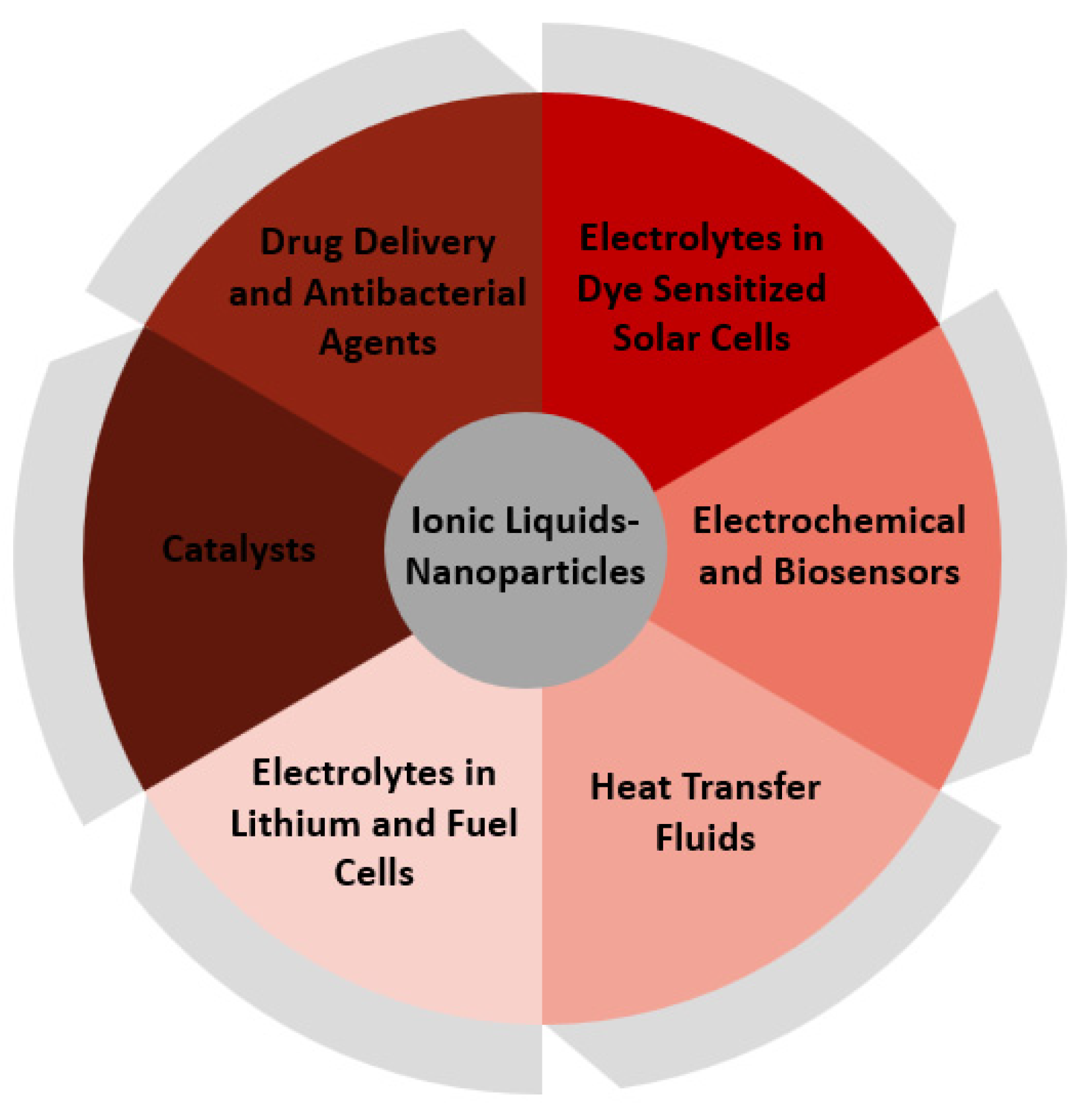
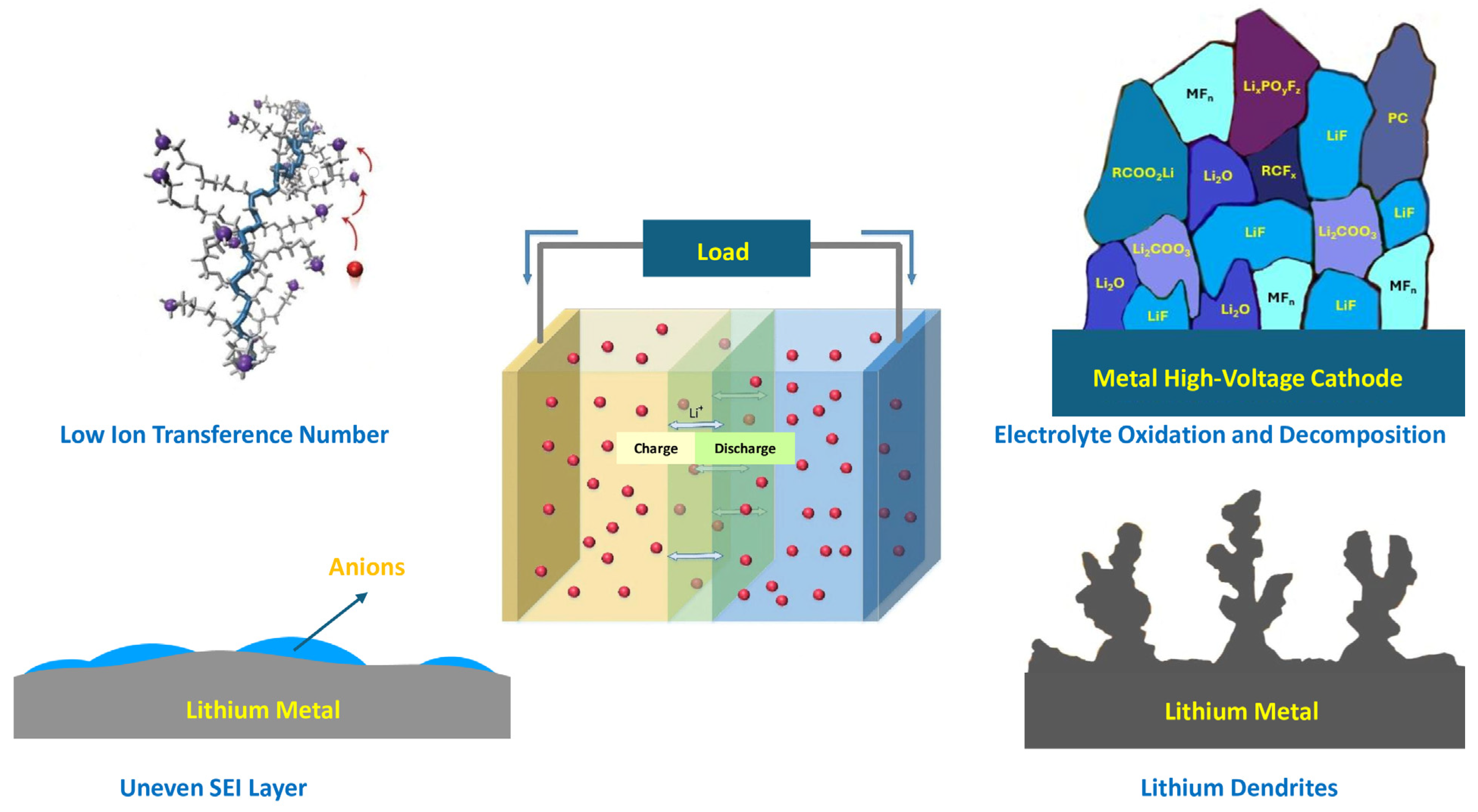


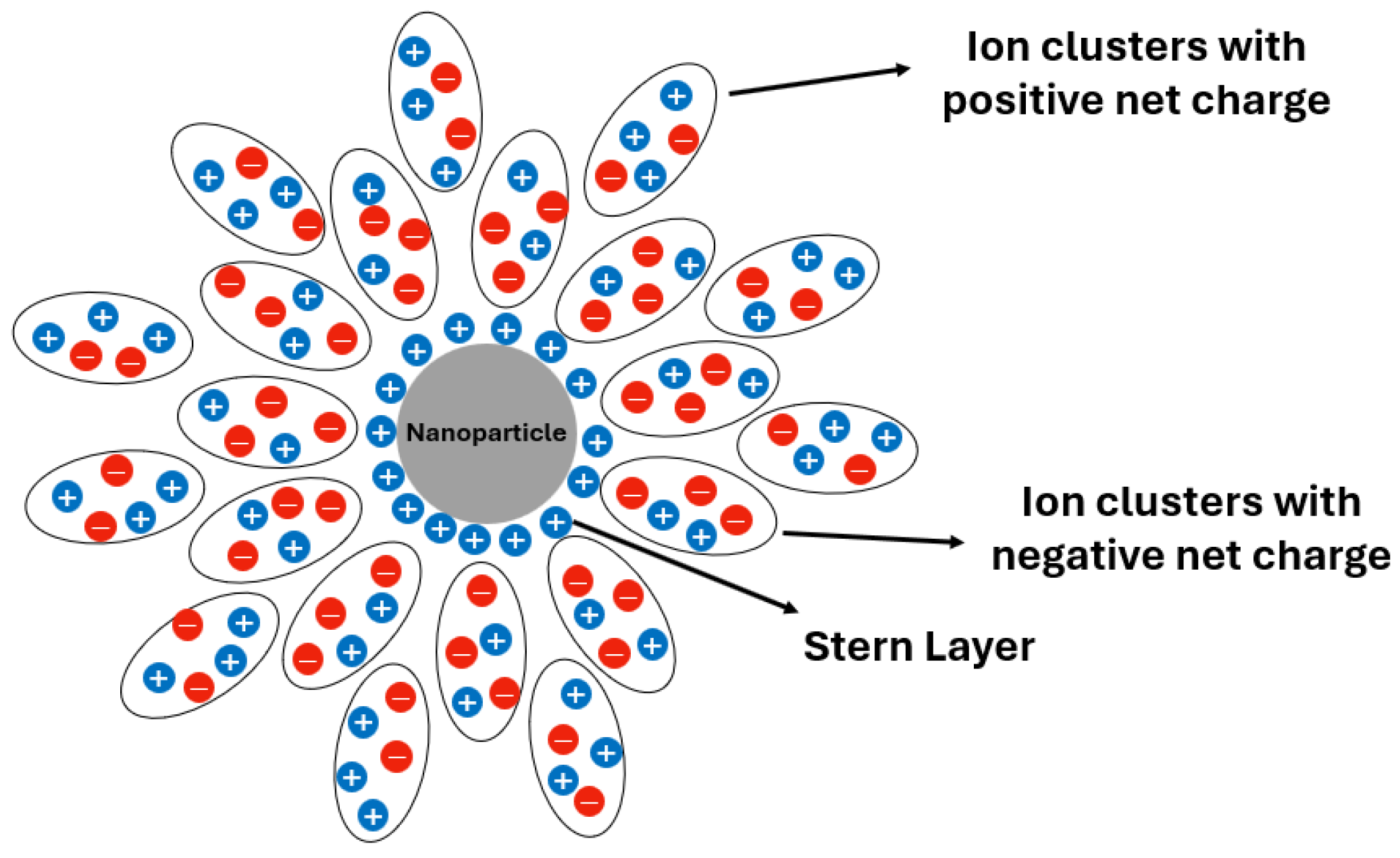
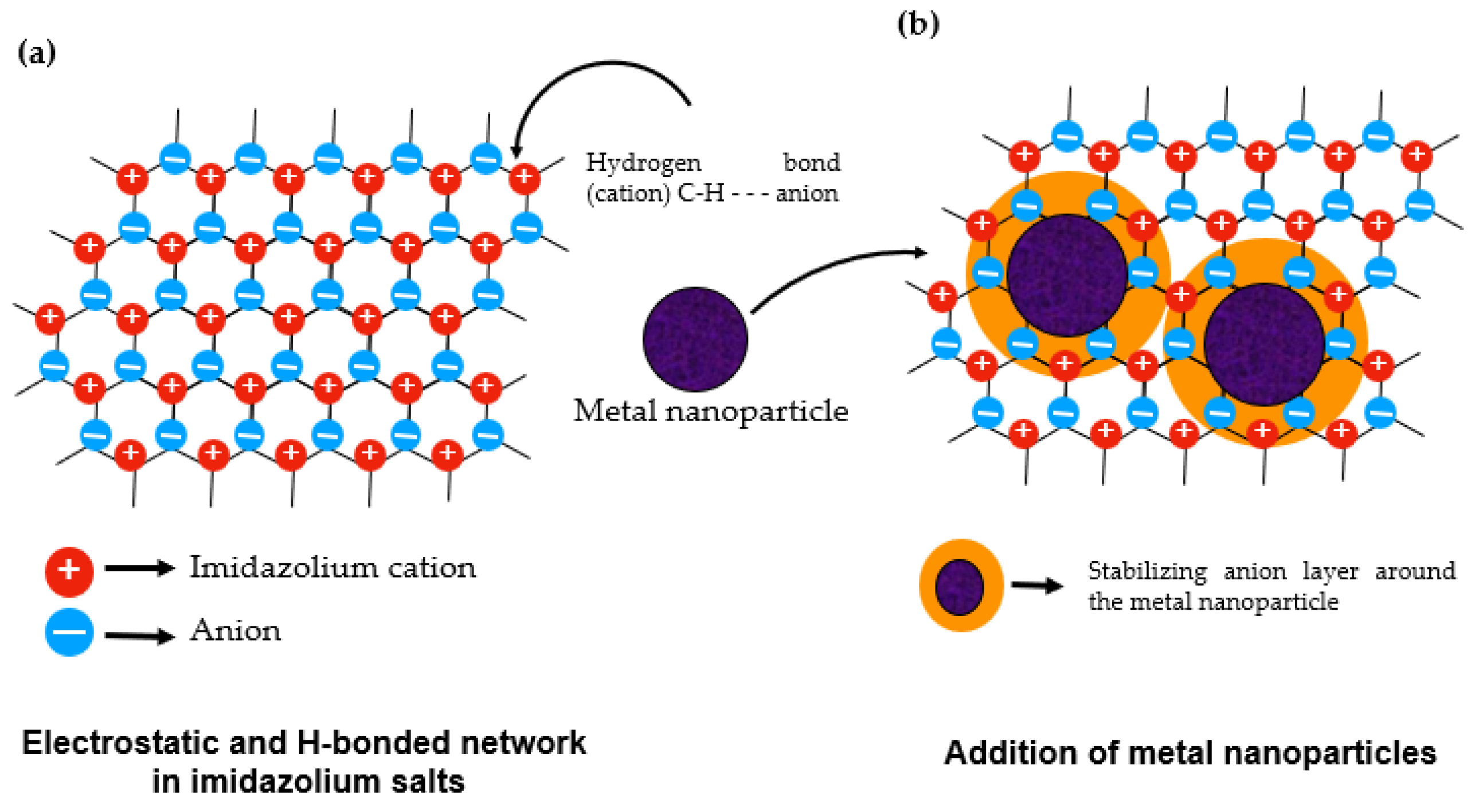



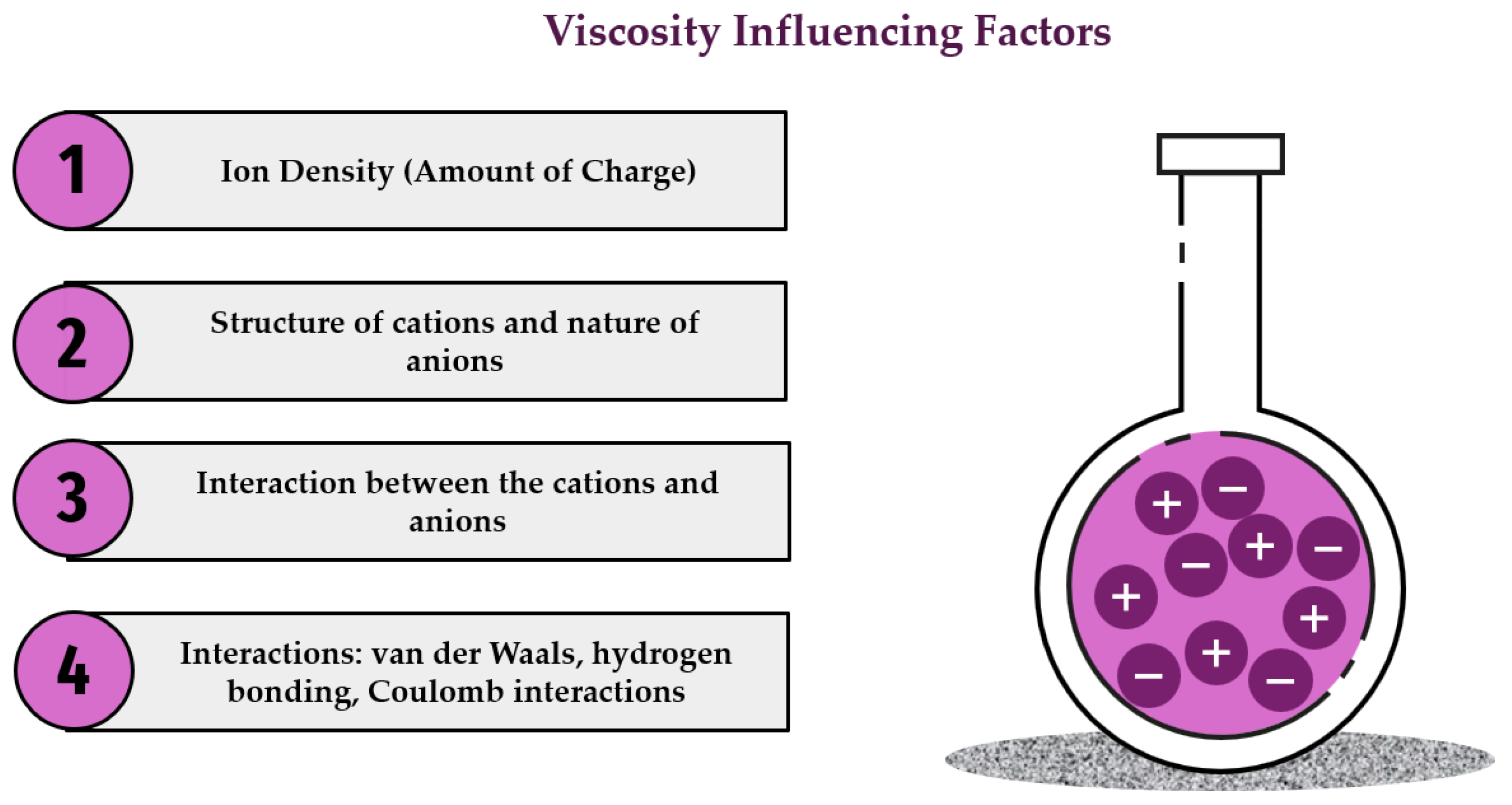
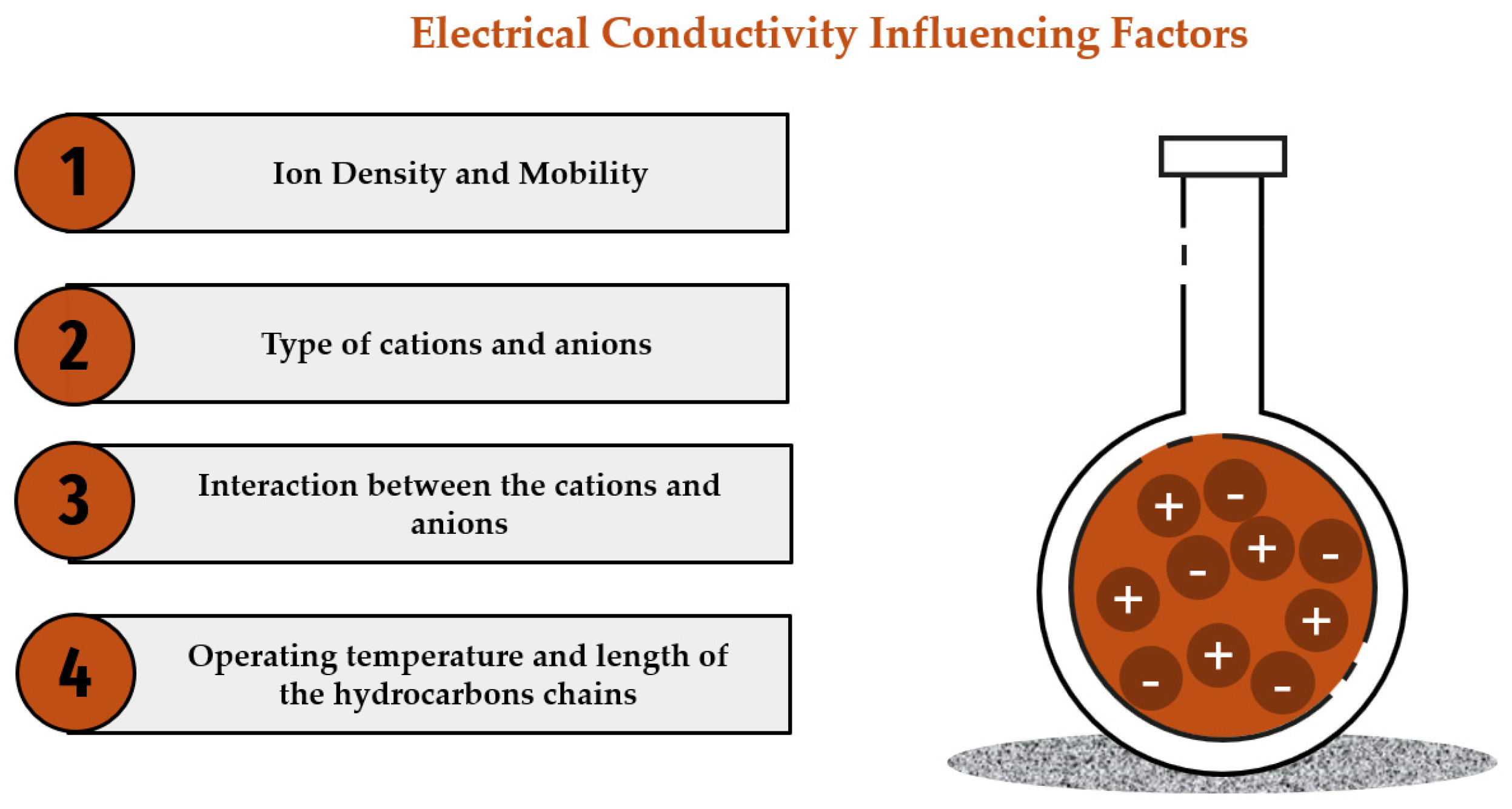

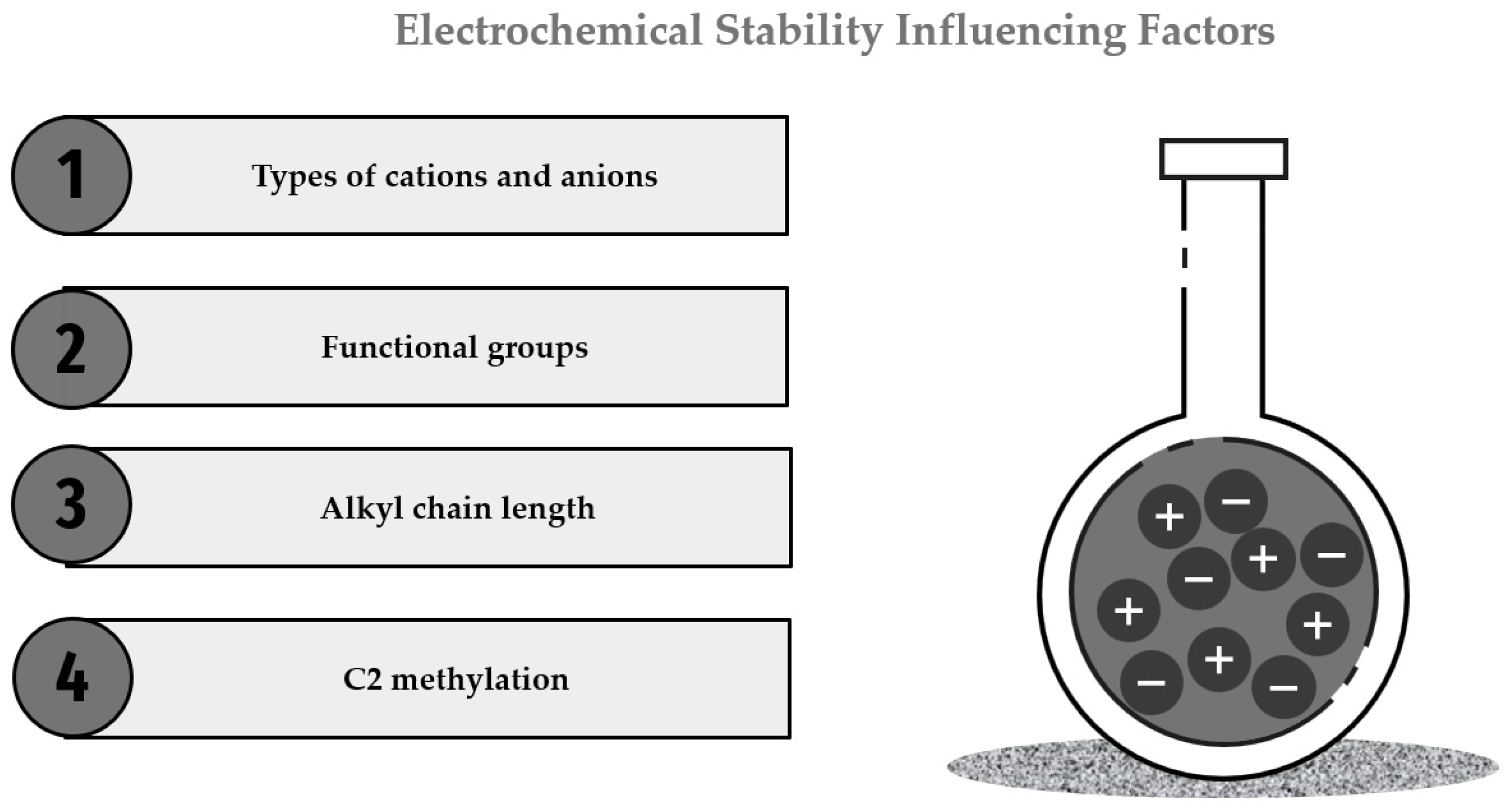

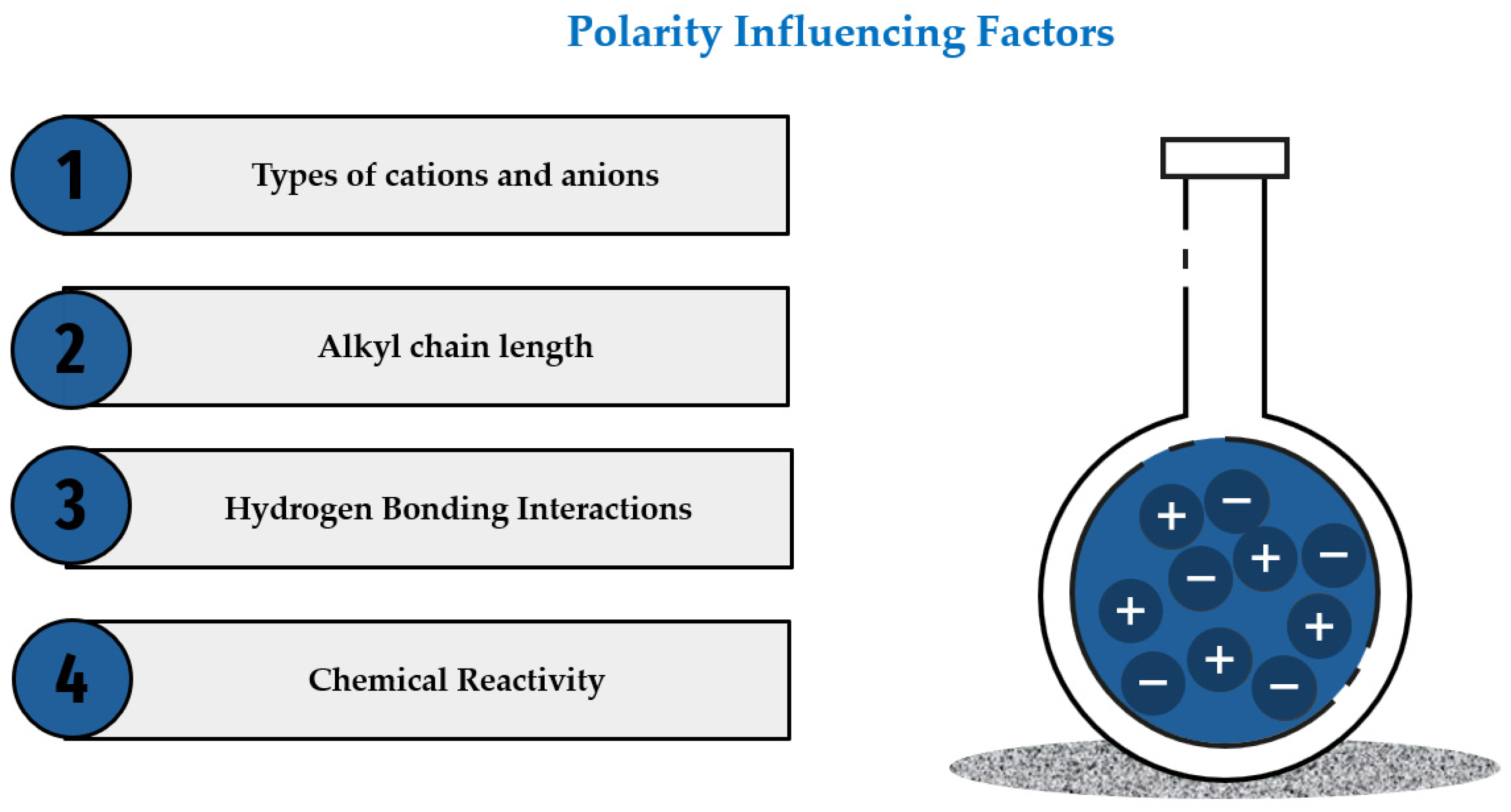
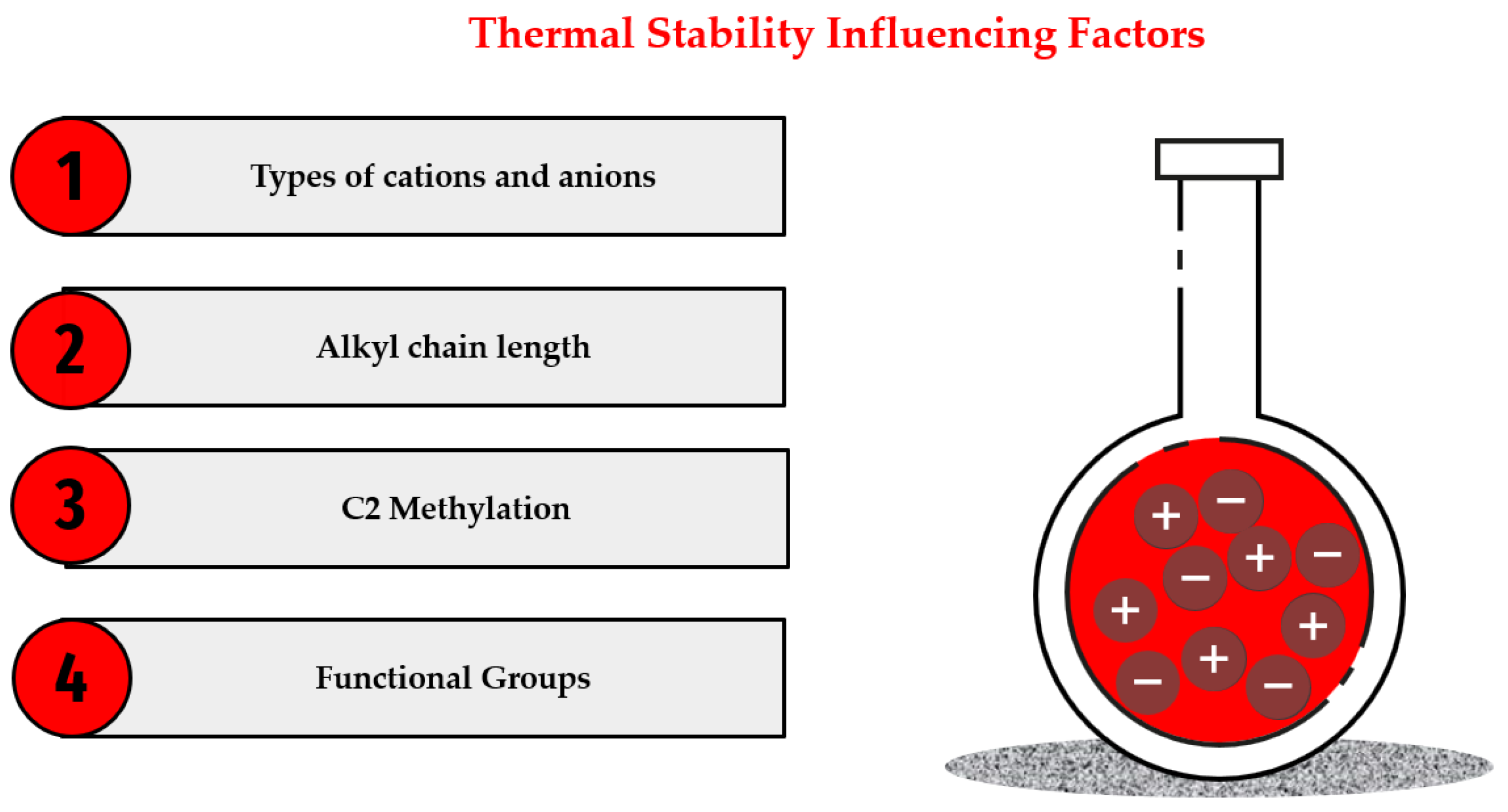
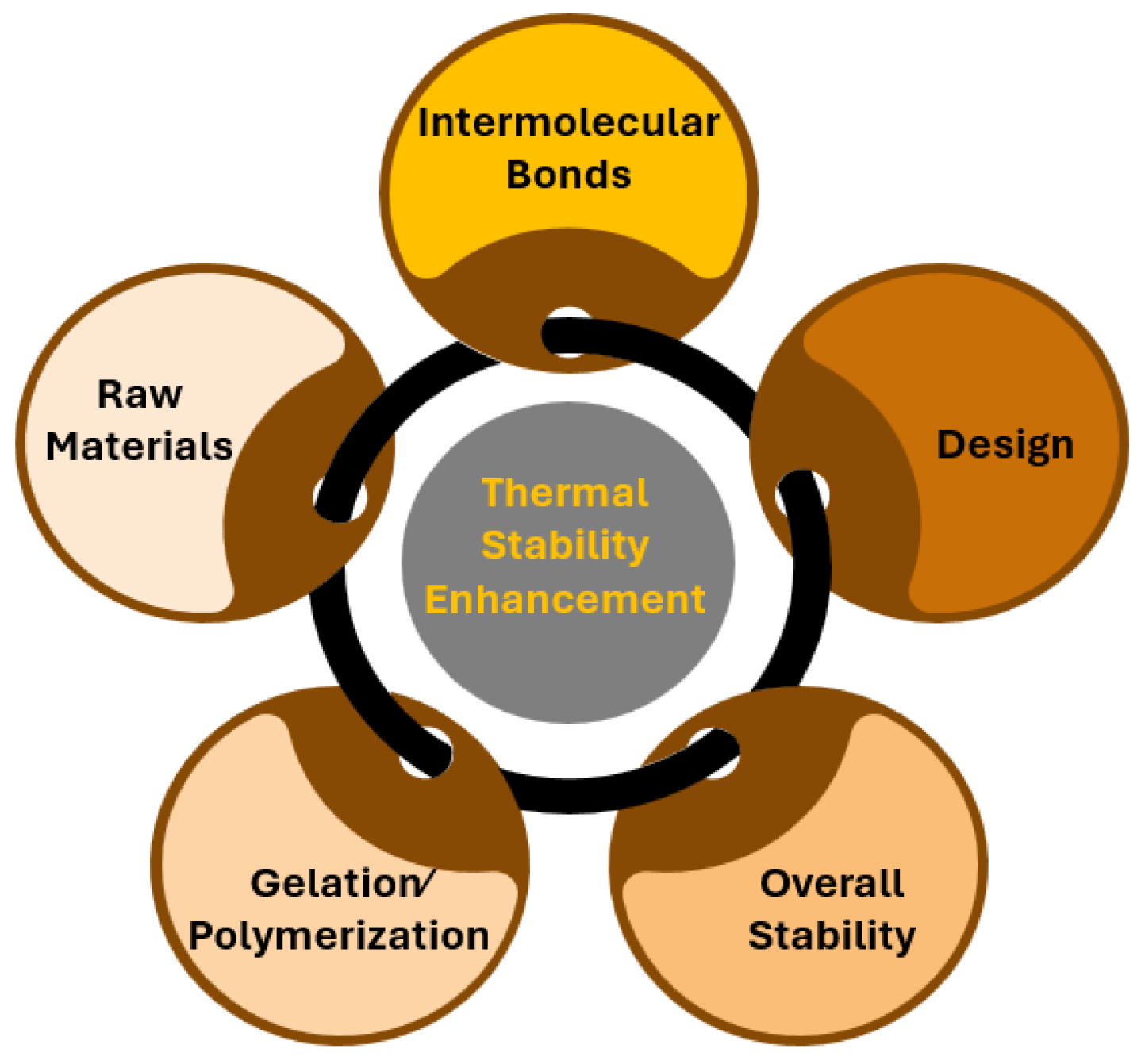

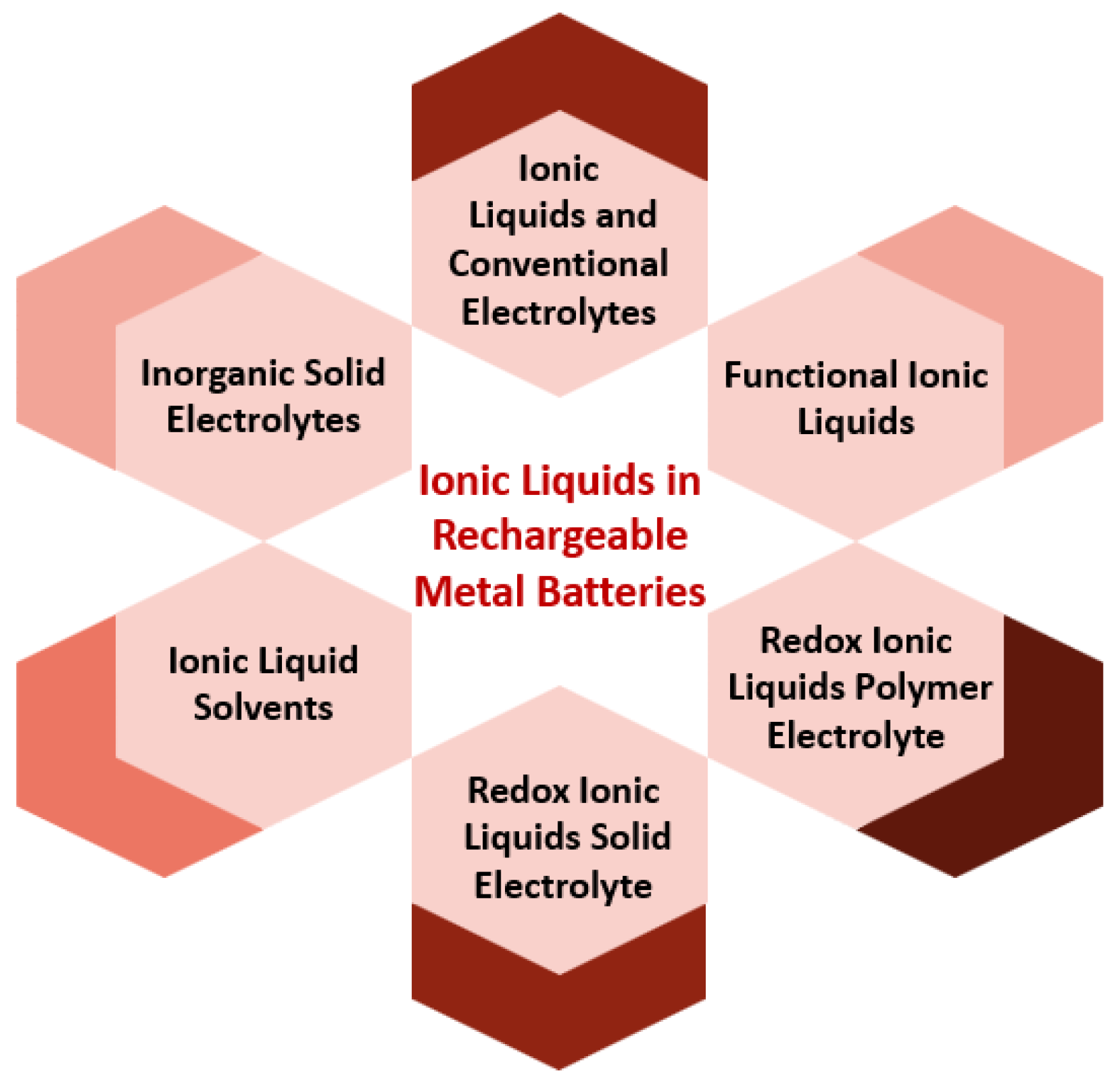

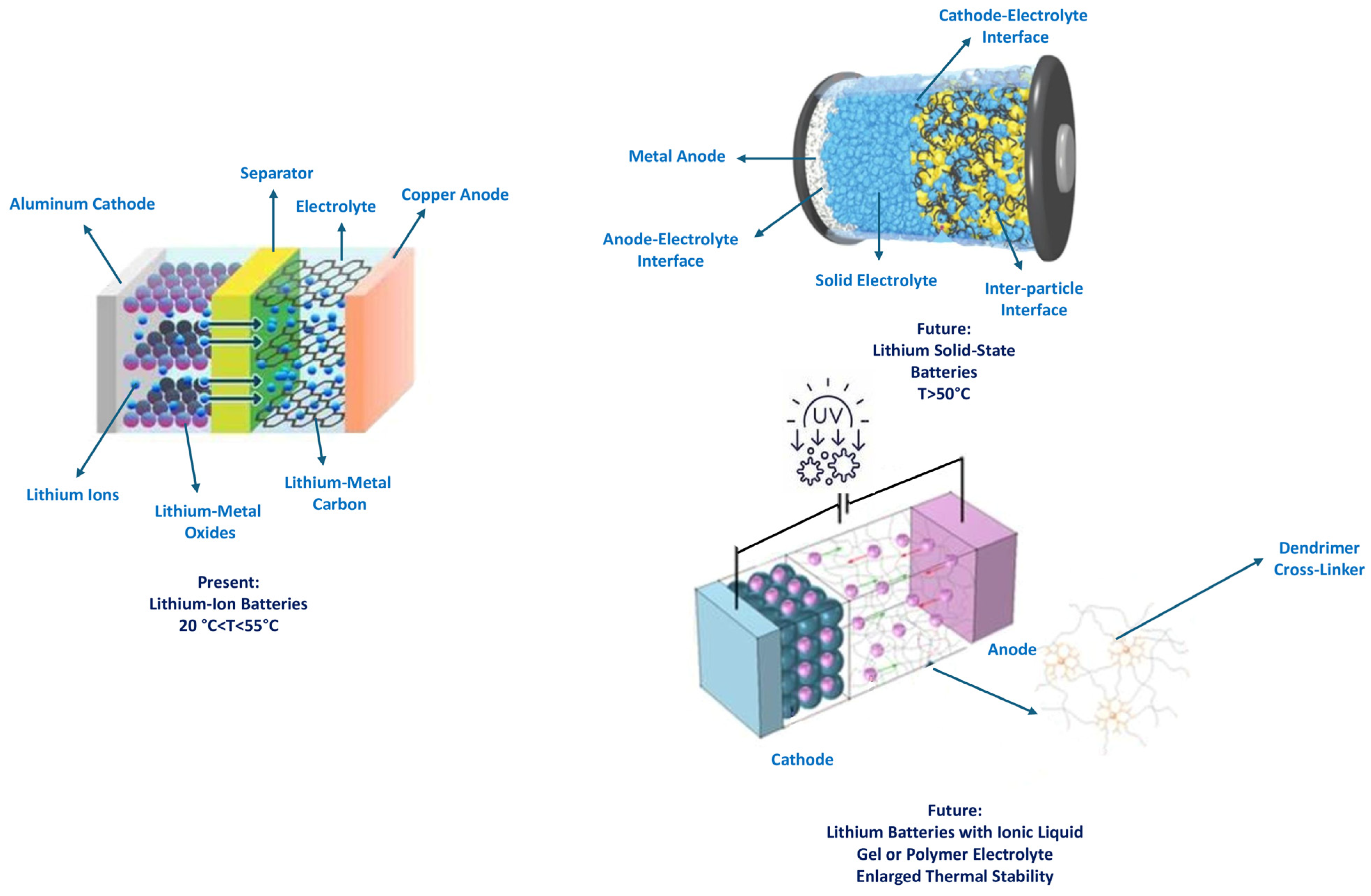
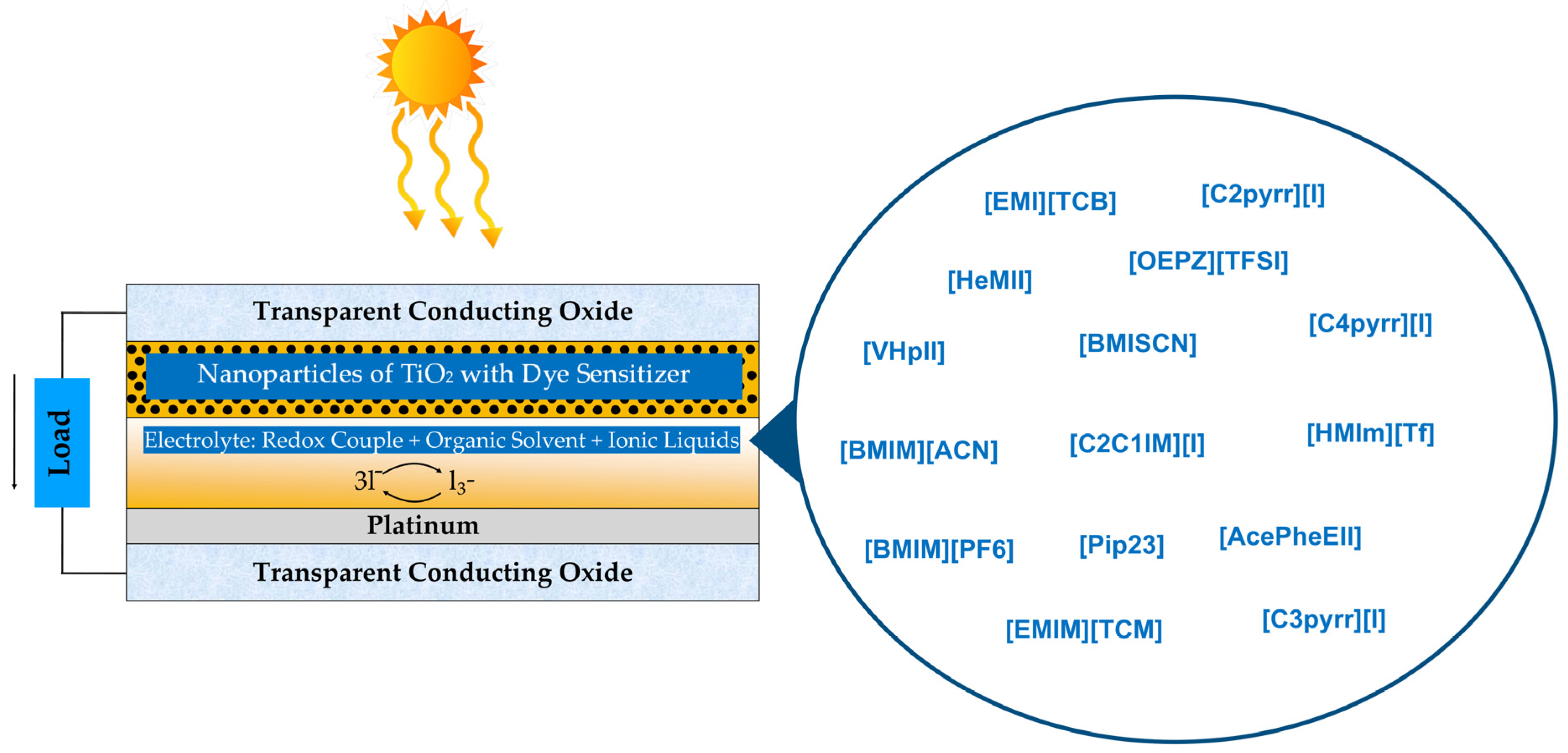
Disclaimer/Publisher’s Note: The statements, opinions and data contained in all publications are solely those of the individual author(s) and contributor(s) and not of MDPI and/or the editor(s). MDPI and/or the editor(s) disclaim responsibility for any injury to people or property resulting from any ideas, methods, instructions or products referred to in the content. |
© 2024 by the authors. Licensee MDPI, Basel, Switzerland. This article is an open access article distributed under the terms and conditions of the Creative Commons Attribution (CC BY) license (https://creativecommons.org/licenses/by/4.0/).
Share and Cite
Pereira, J.; Souza, R.; Moita, A. A Review of Ionic Liquids and Their Composites with Nanoparticles for Electrochemical Applications. Inorganics 2024, 12, 186. https://doi.org/10.3390/inorganics12070186
Pereira J, Souza R, Moita A. A Review of Ionic Liquids and Their Composites with Nanoparticles for Electrochemical Applications. Inorganics. 2024; 12(7):186. https://doi.org/10.3390/inorganics12070186
Chicago/Turabian StylePereira, José, Reinaldo Souza, and Ana Moita. 2024. "A Review of Ionic Liquids and Their Composites with Nanoparticles for Electrochemical Applications" Inorganics 12, no. 7: 186. https://doi.org/10.3390/inorganics12070186






